Keys to Mathematical Treasure Chests
Objects and documents provide signposts alerting us to important stories in the history of mathematics and mathematics education. Publications of the eminent usually receive the most attention from historians. However, instruments made for exploring new subjects, for automating or partially automating mathematical procedures, and for communicating ideas also offer intriguing glimpses into the past, as well as a better understanding of the present. They are representations both of mathematical practice and of the people who contributed to it.
To spread awareness of objects, historians of mathematical instruments have tended to rely on printed publications and on exhibits—be they in museums or in university hallways. In the 21st century, the advent of online databases has made collections information much more widely available. In particular, during the recent COVID-19 pandemic, when museums were closed and libraries had limited access, such databases gained new importance both for staff who work with collections and for those who might like to use them. These databases are capable of revealing—or, occasionally, of hiding—“mathematical treasures” that have sometimes been featured in journals such as Convergence. Indeed, like library catalogs, the databases serve as keys to entire treasure chests—hence the title of this series.
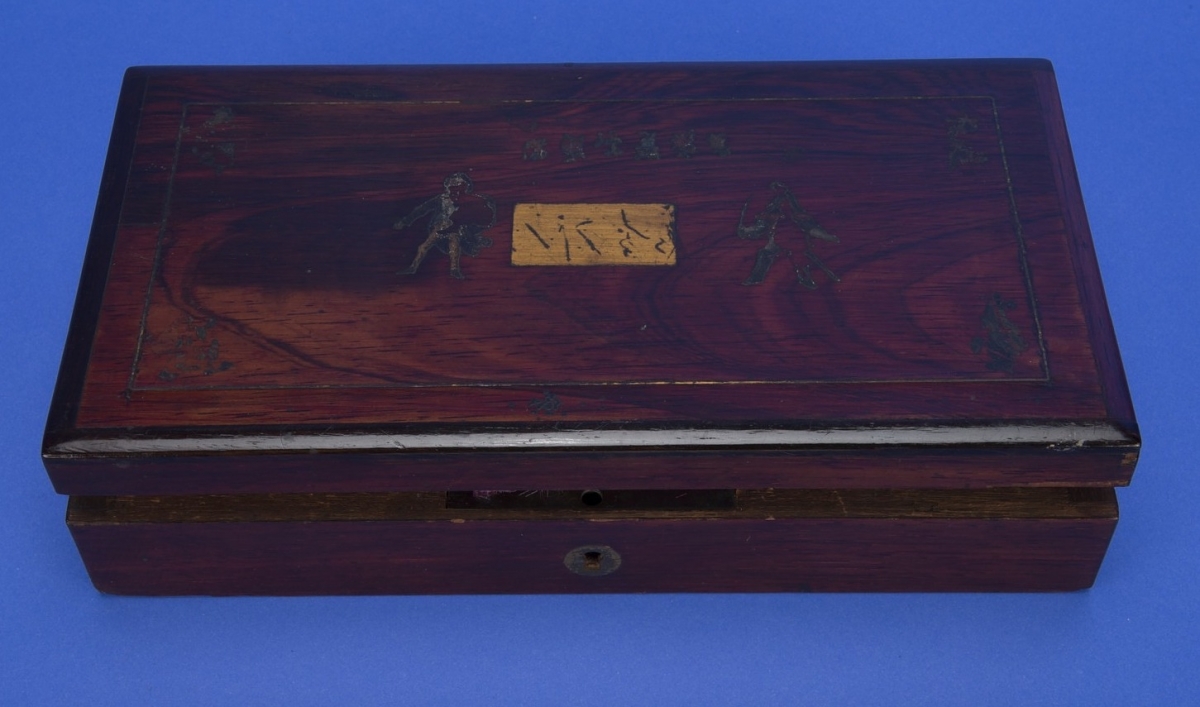
Figure 1. A closed chest of mathematical instruments, as a metaphor for online collections waiting for users
to access them in their research and teaching. Smithsonian Institution negative number NMAH-DOR2013-17228.
Yet, construction of an informative, accessible database does not happen automatically. Good people differ about how best to present collections information. Should one share all the data accumulated over the years, no matter how incomplete or inaccurate—or would this be confusing and misleading to teachers and schoolchildren? How important is standard vocabulary—and whose perspective should one take when choosing terms? For example, many if not most English-speaking people refer to equally divided scales as rulers. Collectors of such things refer to them as rules or scale rules—which term should go online? Is it more important to describe the physical characteristics of an object (which are of great interest to someone who might wish to exhibit it), or the people and companies who made and used it? How important is it to cite sources of the information presented? To what extent is it useful to prepare groups of like objects (such as all the protractors in a collection) and discuss the history of the protractor generally? To what extent should one solicit comments and insights from those consulting the database? Readers may find such questions arcane, but they shape the online databases they might consult. Instructors and historians, especially, may thus find it valuable to keep these questions in mind as they delve into the varied collections databases and institutions introduced in the articles that follow. Quite simply, different museums and archives manage collections differently.
Even though there may not be, for instance, universal standards for formatting information about individual objects, multiple collections databases can be consulted together to enrich academic research into or classroom explorations of specific categories of mathematical objects. This series is designed to carry out some of that legwork for audiences, to offer examples of how these online databases can be mined to unlock the collections that they preserve. It is our hope that readers of Convergence will explore such treasure chests, which may draw together disparate resources that relate to a common endeavor or more deeply explore the collections of a single institution, and consider employing them in today’s mathematics classrooms.
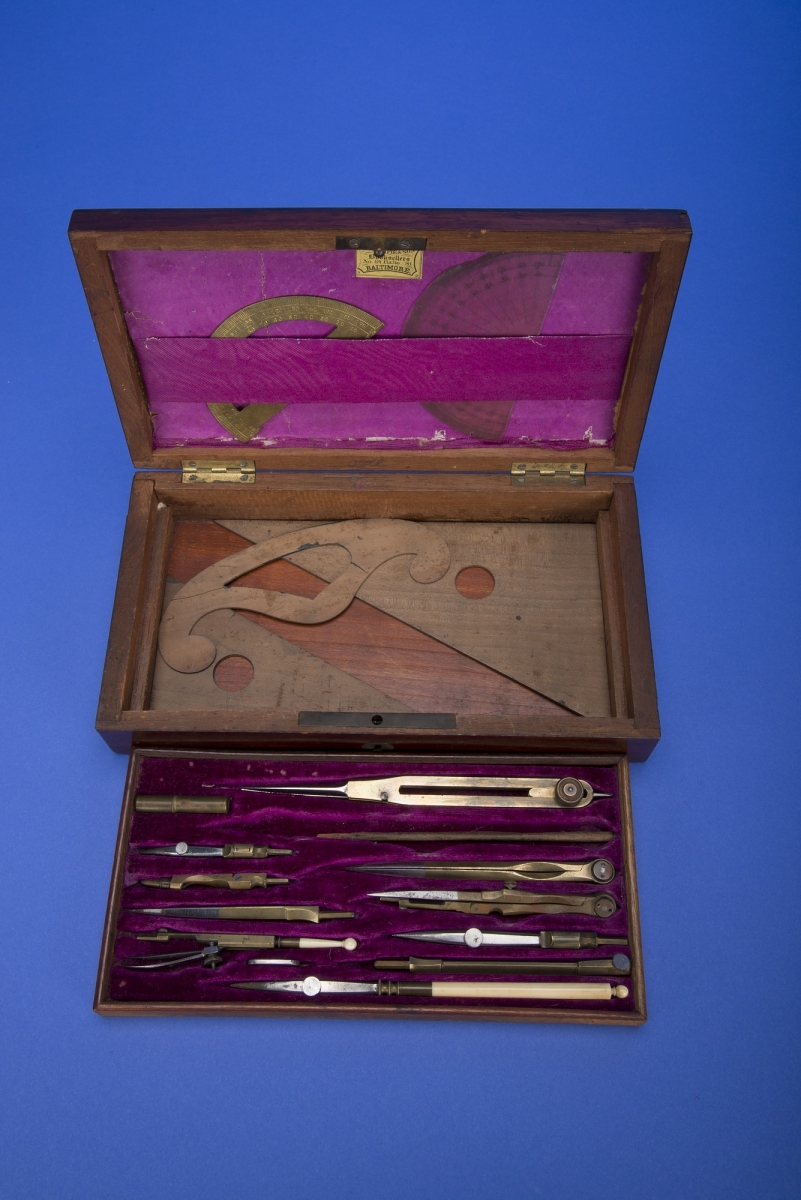
Figure 2. A National Museum of American History database provides the metaphorical “key”
to open this chest, which contains drawing instruments made by the French company
Compas Supérieurs and other makers, sold by the Baltimore bookseller William Minifie & Son
around 1900. Smithsonian Institution negative number NMAH-DOR2013-17228.
Keys to Mathematical Treasure Chests: 19th-century String Models
Roughly forty years ago, a young mathematician teaching about three-dimensional surfaces in a course at Amherst College in Massachusetts laboriously drew an image on the blackboard. A student inquired if the figure represented the same surface as a plaster model sitting in a case at the back of the classroom—part of a group of models the instructor had never carefully examined. It did.

Figure 1. Display case of mathematical objects such as the Amherst student might have noticed.
Assembled at the University of Arizona, ca 1998.
This revelation did not inspire either the student or the mathematician to study the models carefully. However, this anecdote reminds us that Amherst is not the only institution to have invested in models and other teaching apparatus in earlier days. Whether such objects would still assist in teaching specific mathematical topics, I cannot say. They do offer a way to better understand mathematical pedagogy, communities within mathematics, and connections between mathematics and such other disciplines as engineering and the visual arts.
Collections of mathematical instruments in museums, universities, and schools can include general teaching devices from the slate and blackboard to graph paper to the white board. They may comprise digital tools for carrying out arithmetic operations, such as the abacus, adding and calculating machines, and cash registers. Analog computing devices ranging from astrolabes to drawing instruments of various sorts to slide rules may also be found in collections. However, mathematicians intrigued by objects probably puzzle most often over various sorts of mathematical models. As stated above, these objects—made from plaster, wood, metal, string, or plastic—adorn the halls of some mathematics buildings and, sometimes, classrooms. Some of these were purchased from afar, some were constructed locally. Most have been produced by human handiwork, but three-dimensional printing now plays a role. In what follows, I shall describe chronologically one tradition in making models of surfaces that emerged in 19th-century French engineering, was continued by mathematical model makers in Germany and elsewhere, and even influenced the development of string sculpture by Henry Moore and others. There already are fine historical accounts of much of this work—as is the raison d’etre of this series, my emphasis will be on a few databases that allow one to see the stuff . . . or at least images of it!
Keys to Mathematical Treasure Chests: 19th-century String Models – The String Models of Théodore Olivier, Hippolyte Pixii, and Fabre de Lagrange
In the early 19th century, with the rise in descriptive geometry in France under the influence of Gaspard Monge,[1] engineering students were encouraged to examine models, the better to improve their perspective drawings. While not the first geometric models made, these were among the first manufactured and sold for university teaching. More specifically, Théodore Olivier, a student of Monge who was a founding professor at the École Centrale des Arts et Manufactures in Paris, believed that it was important to make abstract mathematical ideas “applicable to terrestrial things” [quoted in Xavier and Pinho 2017, 402]. One way to do this was by embodying them in physical models. In 1829 Olivier designed a relatively simple model for teaching descriptive geometry. Called the “omnibus,” it was a three-dimensional representation of geometric systems composed of line segments, points, and planes so that they could be projected onto a folding cork board. Such a model resembles those by Jullien in Paris later in the century (on Jullien models, see below). According to Xavier and Pinho [2017, 401–402], such models sold widely in Portuguese technical schools at least as late as the 1890s.
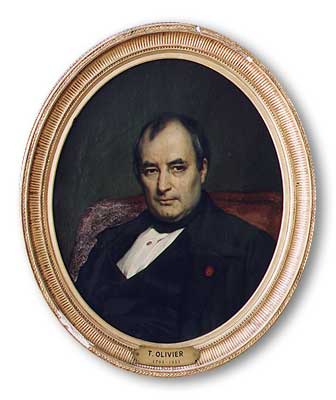
Figure 2. Théodore Olivier (1793–1853). Public domain.
Beginning in the 1830s, Olivier designed several elegant string models with brass frames that were manufactured by the instrument maker Hippolyte Pixii and the firm that succeeded his enterprise, Fabre de Lagrange, both of Paris. These ruled surfaces often were designed to be moveable, the better to illustrate engineering problems. Like the omnibus, they were intended for demonstration to groups of students (rather than manipulation by individuals). Such models apparently were not universally welcomed—according to Olivier, they were even outlawed for a time. However, by the mid-19th century such prohibitions had passed [Xavier and Pinho 2017, 402]. Olivier models spread across Europe and the United States, and would be used at some engineering schools for decades.
Examples of Olivier models were acquired by the Conservatoire des Arts et Métiers (CNAM) in Paris in 1849. These have been catalogued in detail, although not quite all have been photographed.
 To find the Olivier models at the CNAM, go to the main collections database page Collections | Musée des Arts et Metiers (arts-et-metiers.net) and search for "Pixii Père et Fils." Those associated with Olivier have his name listed as well (Olivier’s name is also associated with several other engineering models, so searching for his name is not as useful). There are several ways to view the resulting set of records. Clicking on the title of an object brings up more detailed information.
To find the Olivier models at the CNAM, go to the main collections database page Collections | Musée des Arts et Metiers (arts-et-metiers.net) and search for "Pixii Père et Fils." Those associated with Olivier have his name listed as well (Olivier’s name is also associated with several other engineering models, so searching for his name is not as useful). There are several ways to view the resulting set of records. Clicking on the title of an object brings up more detailed information.
William M. Gillespie, professor of civil engineering at Union College in Schenectady, New York, purchased a set of models from Olivier’s widow in about 1855 and used them in his teaching. These were acquired by the college itself after Gillespie’s death in 1868. In 1995, the models were transferred to the permanent collections of the Mandeville Gallery at Union; eleven of them may be seen on that institution’s website.[2]
The U.S. Military Academy at West Point (USMA) and Harvard University purchased examples of Olivier models in 1857. Historian of mathematics Fred Rickey, an emeritus professor of the USMA, has recorded information about models there and in related collections, making note of the rich historical literature.[3] A few remaining examples from Harvard are in the database of that collection.
 For information about the West Point Olivier models, see Catalogue of Olivier Models (fredrickey.info). For further information Fred Rickey has compiled, see OlivierModels (fredrickey.info). The Harvard models are shown at Results | Search Objects | The Collection of Historical Scientific Instruments (harvard.edu). The general website for searching the collection is The Collection of Historical Scientific Instruments (harvard.edu).
For information about the West Point Olivier models, see Catalogue of Olivier Models (fredrickey.info). For further information Fred Rickey has compiled, see OlivierModels (fredrickey.info). The Harvard models are shown at Results | Search Objects | The Collection of Historical Scientific Instruments (harvard.edu). The general website for searching the collection is The Collection of Historical Scientific Instruments (harvard.edu).
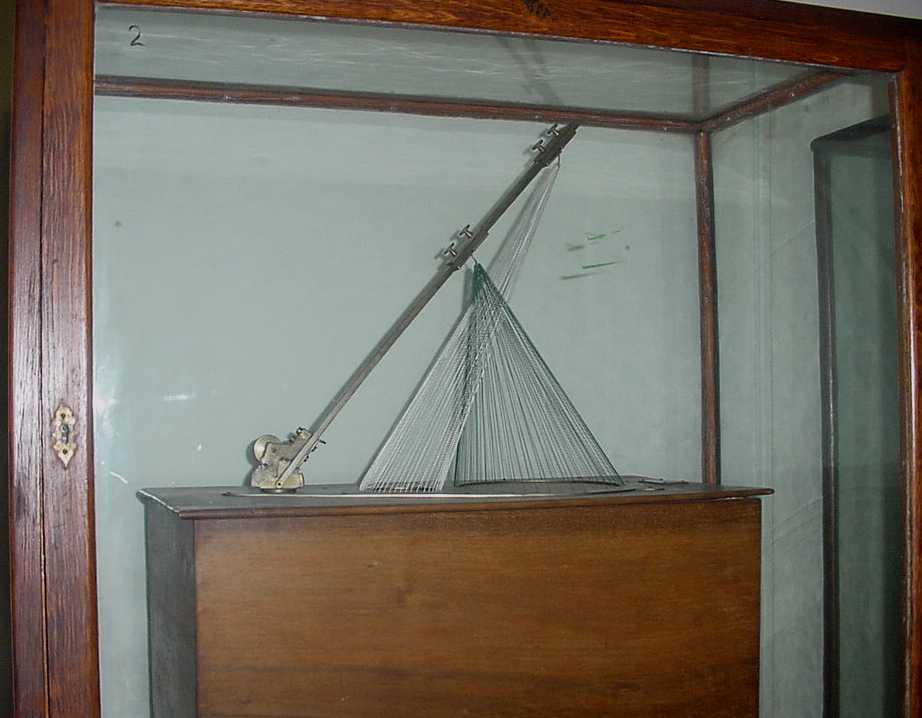
Figure 3. West Point Olivier model depicting the intersection of two cones. Photographed by Amy Shell-Gellasch
ca 2001 and accessed via the Wayback Machine.
Olivier models also attracted attention in Mississippi. Eisso J. Atzema and Gerard Buskes [2009] report that by 1857 Frederick A .P. Barnard asked German immigrant Ferdinand Engel if he might make copies of the Olivier models for the collections he was building at the University of Mississippi. Apparently these do not survive with other materials Barnard collected that are at the University of Mississippi Museum—Atzema and Buskes speculate that Barnard might have taken the models with him when he moved to Columbia University in New York at the time of the American Civil War. Rickey has noted evidence that Columbia indeed did once have such models. As F. C. Moon [2016] and others have mentioned, Cornell University had copies of the Union College Olivier models made locally in the 1860s. Some of these survive, and a few are still on exhibition at Cornell. According to William Stone [1969], Princeton University reportedly ordered copies of these surfaces around 1882, although I have not found evidence that these survive nor do I know who made them.
European technical schools outside of France also took an interest in models for descriptive geometry on Olivier’s design. For example, the Escola Politénica de Lisboa in Lisbon, Portugal, acquired a set from Pixii’s successor, Fabre de Lagrange, in 1861. Not to be outdone, the Instituto Superiur de Engenharia do Porto (ISEP, also in Portugal in the city of Porto) acquired copies of Olivier models made by Sécretan of Paris in 1868 [Xavier and Pinho 2017, 410]. Some twenty-seven of this second group of models survive at the Museum of the ISEP and may be viewed on its database: MUSEU ISEP - Base de Dados (ipp.pt).
 For photographs of an exhibit of some of the Sécretan models for descriptive geometry at the ISEP, see MUSEU ISEP - Abril (ipp.pt). For images of a larger portion of the models, see Modelos (aproged.net). The database of the ISEP Museum, which includes all the models, is at MUSEU ISEP - Base de Dados (ipp.pt). Patricia Costa of that museum gives instructions for use of this database as follows: “Click on ‘entrar como convidado’ (enter as guest), next click on ‘pesquisa’ (search), then write ‘Modelo de geometria descritiva’ (descriptive geometry model) and you can see a list with all of the collection. The information about the models is available only in Portuguese.” Clicking on an item in the list brings up a description and image. Clicking on an image enlarges it. An arrow at the bottom of an individual object record moves one on to the next object record.
For photographs of an exhibit of some of the Sécretan models for descriptive geometry at the ISEP, see MUSEU ISEP - Abril (ipp.pt). For images of a larger portion of the models, see Modelos (aproged.net). The database of the ISEP Museum, which includes all the models, is at MUSEU ISEP - Base de Dados (ipp.pt). Patricia Costa of that museum gives instructions for use of this database as follows: “Click on ‘entrar como convidado’ (enter as guest), next click on ‘pesquisa’ (search), then write ‘Modelo de geometria descritiva’ (descriptive geometry model) and you can see a list with all of the collection. The information about the models is available only in Portuguese.” Clicking on an item in the list brings up a description and image. Clicking on an image enlarges it. An arrow at the bottom of an individual object record moves one on to the next object record.
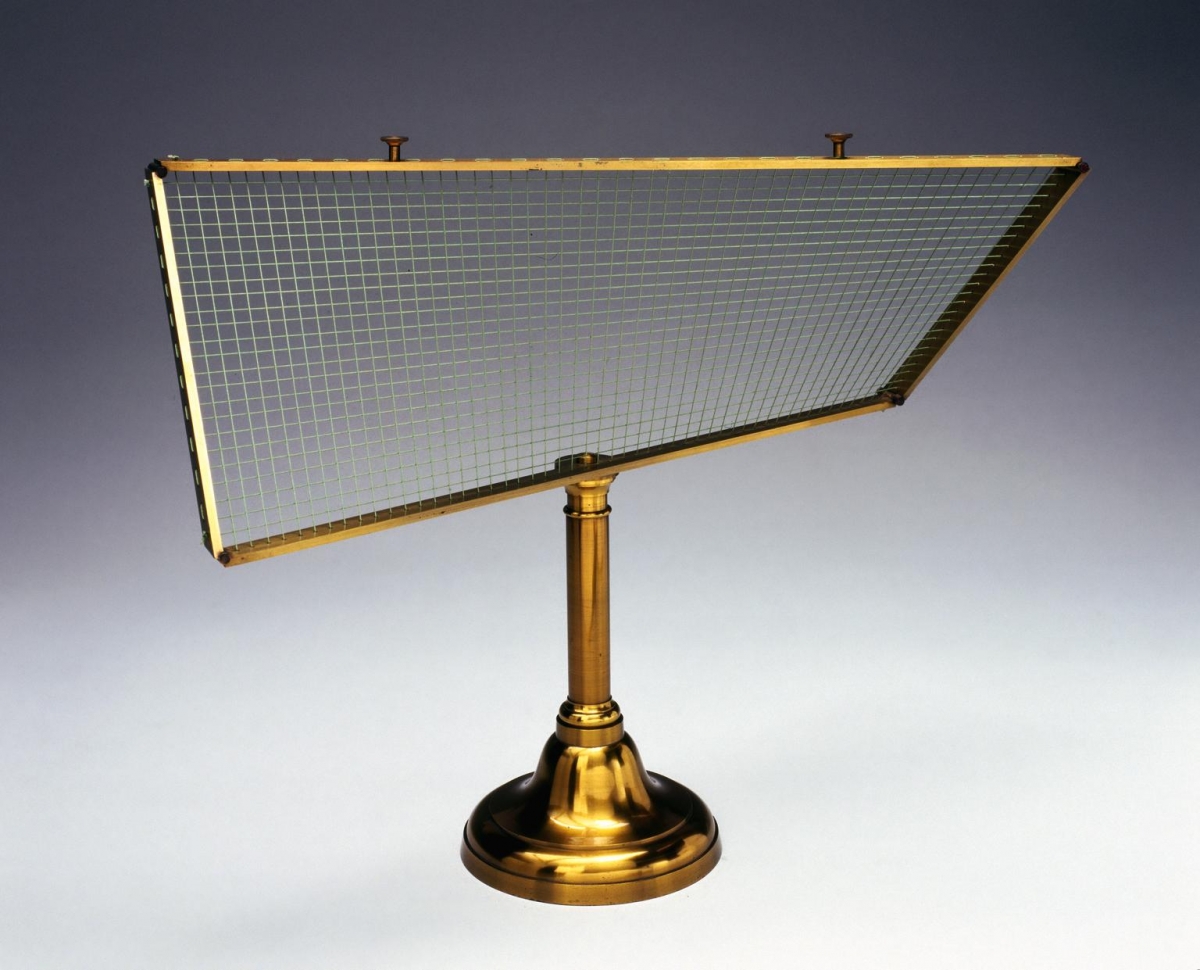
Figure 4. Olivier model of a hyperbolic paraboloid made by Fabre de Lagrange in 1872. Science Museum object number 1872-96, made available via Creative Commons Attribution-NonCommercial-ShareAlike 4.0 Licence.
The Science Museum in London acquired a set of Olivier-style models made by Fabre de Lagrange in 1872. About a century later, the institution transferred part of this acquisition to the Canadian Museum of Science and Technology (now part of the Ingenium) in Ottawa.[4] Models from this acquisition may be seen at both museums’ websites.
 For those in the Science Museum collections, see Fabre de Lagrange | Science Museum Group Collection. For those at the Ingenium, see Collection Online (Beta) - Ingenium (ingeniumcanada.org) and search for “Lagrange.” The results may be found at Collection Online (Beta) - Ingenium (ingeniumcanada.org). Clicking on the name of an object brings up descriptions. At this writing, there are no photographs.
For those in the Science Museum collections, see Fabre de Lagrange | Science Museum Group Collection. For those at the Ingenium, see Collection Online (Beta) - Ingenium (ingeniumcanada.org) and search for “Lagrange.” The results may be found at Collection Online (Beta) - Ingenium (ingeniumcanada.org). Clicking on the name of an object brings up descriptions. At this writing, there are no photographs.
Curator Barry Phipps and colleagues mounted an exhibit in 2012 that explored connections between the Science Museum models and string sculpture, particularly that of Henry Moore; it appeared jointly at the Science Museum and at the Royal Society of London. A copy of the elegantly illustrated exhibit catalog is available online [Phipps et al. 2012].
By the late 19th century, smaller, less elegant, but less expensive models for descriptive geometry—more like Olivier’s original omnibus—were available. One such set, made in the mid-1870s on the design of the Parisian textbook author A. Jullien, is in the Smithsonian collections and has been catalogued in detail by Amy Shell-Gellasch: https://americanhistory.si.edu/collections/object-groups/geometric-models-jullien-models-for-descriptive-geometry. (This object is also a Convergence Mathematical Treasure.)
[1] For a discussion of the international diffusion of the teaching of descriptive geometry and the founding of diverse polytechnic schools, see [Barbin et al. 2019]. The volume focuses on textbooks and educational institutions, not models.
[2] For an account of the history of the Olivier models at Union, see Castrucci Gallery: Olivier Models at Union College | Mandeville Gallery. A useful published introduction to these and other Olivier models is [Stone 1969].
[3] Print publications on the USMA Olivier models include [Shell-Gellasch 2003] and [Acheson 2007].
[4] For a discussion of Olivier models, particularly those that ended up in Canada, see [Pantalony 2017, esp. pp. 263–265].
Keys to Mathematical Treasure Chests: 19th-century String Models – Later Makers of String Models
The relatively simple paper models made by Jullien generally show the projection of a few line segments onto perpendicular planes. Some model makers continued the tradition of making more elaborate ruled surfaces, although they generally described them as mathematical (rather than engineering) models. Those distributed most widely were made and sold by the Germans Ludwig Brill and his successor Martin Schilling. Examples of these survive in collections across the world. About twenty are in the Smithsonian’s National Museum of American History (NMAH), most from a collection of Brill models exhibited at the World’s Fair held in Chicago in 1893. Brill's successor, Martin Schilling, would continue to sell these models well into the 20th century.
 For examples of Brill models of ruled surfaces in the Smithsonian collections, see https://americanhistory.si.edu/collections/search?return_all=1&edan_local=1&edan_q=Brill%20%22ruled%20surface%22%20metal%20Wesleyan. This chest has an extra treasure!
For examples of Brill models of ruled surfaces in the Smithsonian collections, see https://americanhistory.si.edu/collections/search?return_all=1&edan_local=1&edan_q=Brill%20%22ruled%20surface%22%20metal%20Wesleyan. This chest has an extra treasure!
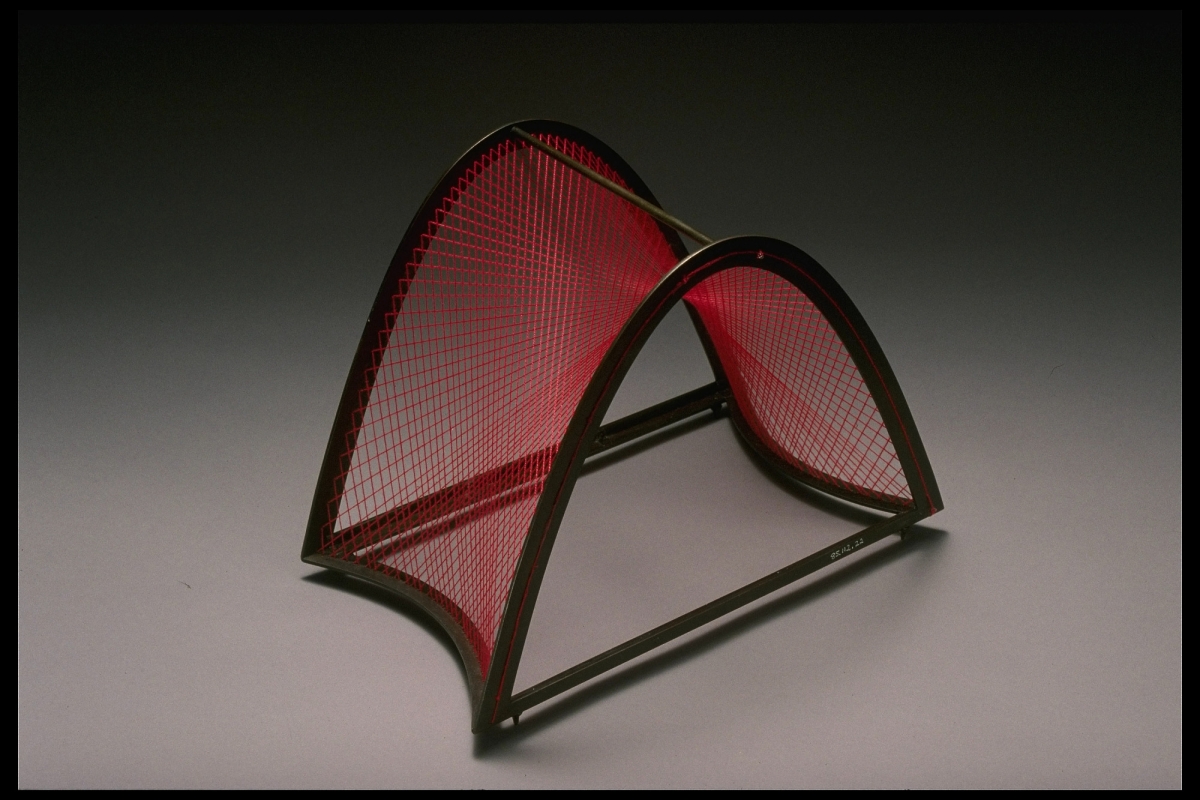
Figure 5. Brill’s model of a hyperbolic paraboloid, 1892. Smithsonian Institution negative number NMAH-97-9530.
American model makers such as the firm of Eberbach in Ann Arbor, Michigan, and University of Iowa professor Richard P. Baker made similar models in the late 19th and early 20th centuries—examples of these also survive at the Smithsonian and, in Baker’s case, at the University of Arizona. Baker distributed his models into the 1930s.
 For two Eberbach models of ruled surfaces, see https://americanhistory.si.edu/collections/search/object/nmah_1213977 and https://americanhistory.si.edu/collections/search/object/nmah_1196291. Two related, unsigned models from the University of Michigan are https://americanhistory.si.edu/collections/search/object/nmah_1213978 and https://americanhistory.si.edu/collections/search/object/nmah_213480.
For two Eberbach models of ruled surfaces, see https://americanhistory.si.edu/collections/search/object/nmah_1213977 and https://americanhistory.si.edu/collections/search/object/nmah_1196291. Two related, unsigned models from the University of Michigan are https://americanhistory.si.edu/collections/search/object/nmah_1213978 and https://americanhistory.si.edu/collections/search/object/nmah_213480.
 For Baker’s string models of ruled surfaces, see https://americanhistory.si.edu/collections/search?return_all=1&edan_local=1&edan_q=Baker%20ruled%20surface&. Examples of Baker models of ruled surfaces are also found at the University of Arizona. See Mathematical Models at the University of Arizona, particularly under “Ruled surfaces.” Not all of the ruled surfaces shown at this address are by Baker.
For Baker’s string models of ruled surfaces, see https://americanhistory.si.edu/collections/search?return_all=1&edan_local=1&edan_q=Baker%20ruled%20surface&. Examples of Baker models of ruled surfaces are also found at the University of Arizona. See Mathematical Models at the University of Arizona, particularly under “Ruled surfaces.” Not all of the ruled surfaces shown at this address are by Baker.
Keys to Mathematical Treasure Chests: 19th-century String Models – Conclusion and References
Conclusion
In the mid-20th century, the focus of mathematical research and instruction moved away from the relatively simple surfaces represented by models. Engineering schools also found models of less use to their instructional purposes. Indeed, by the end of the century, computer graphics had replaced much of physical modelling. Nonetheless, as the case of models for descriptive geometry well illustrates, a rich array of mathematical treasures are now available not only through written texts but through diverse—and expanding—databases.
References
Acheson, Bill. 2007. “Geometric String Models of Descriptive Geometry.” In Hands on History, edited by Amy Shell-Gellasch, 49–62. Washington, DC: MAA.
Atzema, Eisso J., and Gerard Buskes. 2009. “‘Engel’s Ingenious Models’: on the Models of the Fresnel Wave Surface at the University of Mississippi.” Rittenhouse 22(1): 90–122.
Barbin, Evelyne, Marta Menghini, and Klaus Volkert, eds. 2019. Descriptive Geometry, the Spread of a Polytechnic Art: The Legacy of Gaspard Monge. Cham, Switzerland: Springer.
Moon, Francis C., and John F. Abel. 2016. “19th c. Olivier String Models at Cornell University: Ruled Surfaces in Gear Design.” In Explorations in the History of Machines and Mechanisms, edited by C. López-Cajún and M. Ceccarelli, 195–207. Cham: Springer.
Pantalony, David. 2017. “Collectors Displays and Replicas in Context: What We Can Learn from Provenance Research in Science Museums.” In The Romance of Science: Essays in Honour of Trevor H. Levere, edited by Jed Buchwald and Larry Stewart, 257–275. Cham: Springer.
Phipps, Barry et al. 2012. Intersections: Henry Moore and Stringed Surfaces. London: Royal Society of London.
Shell-Gellasch, Amy. 2003. “The Olivier Models at West Point.” Rittenhouse 17(2): 71–84.
Stone, William C. 1969. The Olivier Models. Schenectady, NY: Friends of the Union College Library.
Xavier, J. P., and E. M. Pinho. 2017. “Olivier String Models and the Teaching of Descriptive Geometry,” In Dig Where You Stand. Proceedings of the Fourth International Conference on the History of Mathematics Education, edited by K. Bjarnadóttir, F. Furinghetti, M. Menghini, J. Prytz, and G. Schubring, 399–414. Rome: Edizioni Nuova Cultura.
Collections
Catalogue of Olivier Models, Frederick V. Rickey, United States Military Academy (emeritus).
Conservatoire des Arts et Métiers Collections, Musée des Arts et Metiers, Paris, FR.
Ingenium Collection Online (Beta), Canadian Museums of Science and Innovation, Ottawa, ON.
Mathematical Models Collection, Department of Mathematics, University of Arizona, Tucson, AZ.
MUSEU ISEP Collections, Museu do Instituto Superior de Engenharia do Porto, Porto, Portugal.
National Museum of American History Collections, Smithsonian Institution, Washington, DC.
Science Museum Group Collection, Science Museum of London, London, UK.
The Collection of Historical Scientific Instruments, Harvard University, Cambridge, MA.
Acknowledgements
Historians of mathematics and museum staff who have assisted in searching specific collections are generally mentioned in the text. I thank them as well as Smithsonian colleagues, especially Judy Green and Rhoda Ratner, for their work with Smithsonian examples of the models. Finally, I am most grateful to those associated with Convergence for numerous improvements to the article.
About the Author
After undergraduate work in physics and graduate study in the history of science, Peggy Aldrich Kidwell became a postdoctoral fellow at NMAH. She then began working in the mathematics collections, curating materials ranging from an 11th-century astrolabe to a 21st-century whiteboard. She and colleagues have written numerous articles and books on the history of mathematical instruments and computers and prepared diverse exhibits showcasing these artifacts. They also have spent much of the past decade preparing online accounts of objects.
Keys to Mathematical Treasure Chests: Andean Khipus
First designated a Convergence Mathematical Treasure in 2008, Andean khipus (also spelled quipus or kipus) are among the most distinctive recordkeeping devices known to scholars from disciplines as varied as history, mathematics, anthropology, and computer science (see Figure 1). For at least 1,000 years (ca 950–1950 CE), Andean peoples used these bunches of knotted strings for recording numerical and non-numerical information. Khipu use is most famously associated with the Inka Empire (ca 1400–1532 CE), whose administrators utilized khipus to maintain accounts of millions of people, as well as—according to some colonial-era chronicles—annals, genealogical records, and songs. The system of base-10 numerical knots on most khipus was only deciphered about one hundred years ago, by the Brooklyn, NY, teacher and historian of mathematics L. Leland Locke (1875–1943) [1923].
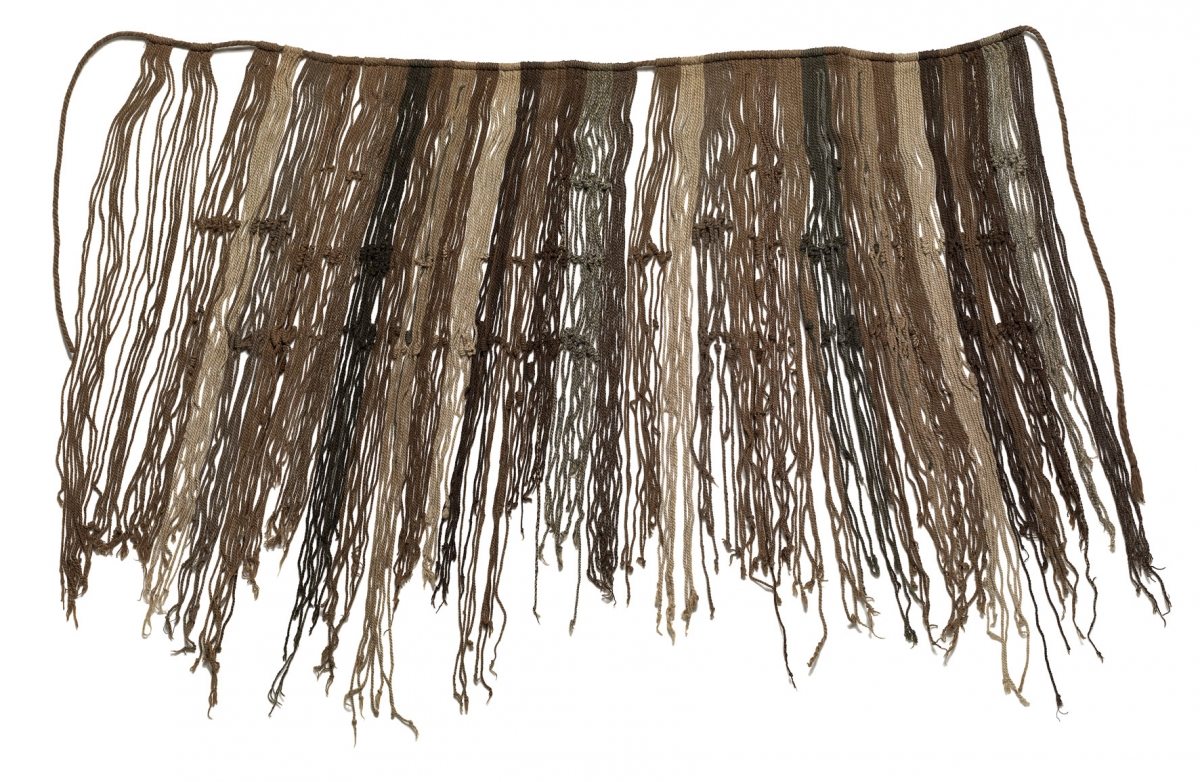
Figure 1. Inka-style khipu VA 16148 in the Ethnologisches Museum, Berlin (© Ethnologisches Museum, Staatliche Museen zu Berlin, made available via Creative Commons Attribution-NonCommercial-ShareAlike 4.0 License).
See the online record at https://smb.museum-digital.de/object/28561.
In the century since Locke’s numerical breakthrough, efforts to interpret khipus’ other, potentially non-numerical elements have been pushed forward by scholars with considerable speed. Rubén Urbizagástegui Alvarado [2014] estimated that over 50% of the 800+ khipu-related works published since 1533 CE have emerged in the last 20 years. Such a flurry of activity by researchers around the world, while exciting, has nonetheless rendered it difficult for interested observers to keep pace with the range of theories, hypotheses, and—of particular interest here—the available digital records of khipus themselves.
This article thus endeavors to compile online and open-access resources that offer various entry points into the world of khipu studies. In doing so, I hope to highlight the multiple contributions of works on the khipu published outside of (and in addition to) traditional academic works such as journal articles, monographs, and edited volumes. Readers will also be introduced to a broad diversity of khipu traditions along the way. Indeed, it would be difficult to avoid the variety of locales and styles represented by these objects, given that Inka khipus represent less than 15% of the lifespan of active khipu use in the Andes.
In an effort to reflect the khipu research landscape, I have organized this piece to mirror two of the field’s most well-developed foci:
- the documentation of individual artifacts and collections by museums; and
- quantitative and digital analysis projects that aim to uncover khipus’ undeciphered contents.
I hope to show that each of these is well-represented among existing online resources and can serve teaching and research in diverse ways.
Keys to Mathematical Treasure Chests: Andean Khipus – Museum Collections and Documentation
Two basic but important questions are worth addressing up front: How many khipus survive today? Where are they located? As of 2021, I have found there to be at least 1,386 khipus in 143 museums and private collections in over 20 countries (see Figure 2). These are tabulated in an online appendix accompanying my recent book, which introduces non-specialist readers to khipus and khipu research [Medrano 2021b]. Additional specimens continue to emerge from ongoing archaeological work in the Andes, with Inka-era accounting contexts particularly well-represented in recent years (e.g., Barraza Lescano, Areche Espinola, and Marcone Flores [2022]; Clindaniel [2019, chap. 4]). Most khipus in museum collections were excavated on the Peruvian coast between the late 19th and early 20th centuries, with hundreds removed from the Andes and subsequently deposited in North America, Europe, and Asia.
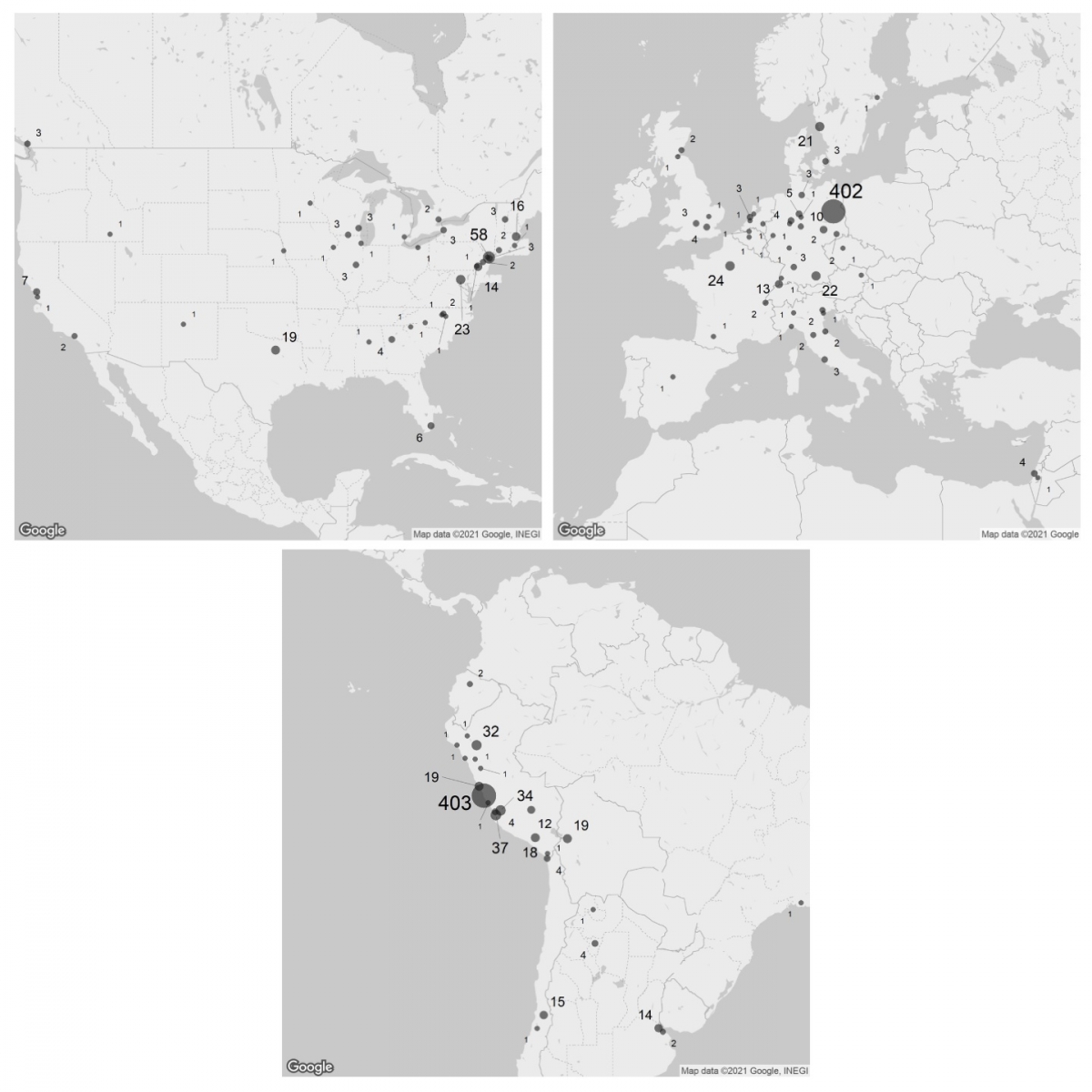
Figure 2. Andean khipus in museums and private collections (maps by Manuel Medrano).
Some collections are grouped by geographic proximity; see [Medrano 2021b].
Fortunately, many, if not most, khipus from among the global corpus have been photographed and can be found online. The museum databases associated with the largest khipu collections are a logical starting point; each online platform offers distinct benefits to interested users.
 Searching “khipu” on the collections portal of the Ethnologisches Museum, Berlin yields about 300 matches, with relatively large thumbnails arranged in a grid aiding high-level comparison. Most objects’ entries list the names of their collectors (largely Germans) and reported find spots. The larger khipus also have accompanying notes describing the arrangement of strings, their diameters, and their colors, for the most part written in English. To find especially high-resolution images of several khipus in the Berlin collection, see the portfolio produced for MacGuffin Magazine by Mathijs Labadie, a Rotterdam-based photographer. The accession numbers for several of the specimens can be found by zooming in on the affixed tags. Entering the numbers into the Berlin collections portal will then yield further information.
Searching “khipu” on the collections portal of the Ethnologisches Museum, Berlin yields about 300 matches, with relatively large thumbnails arranged in a grid aiding high-level comparison. Most objects’ entries list the names of their collectors (largely Germans) and reported find spots. The larger khipus also have accompanying notes describing the arrangement of strings, their diameters, and their colors, for the most part written in English. To find especially high-resolution images of several khipus in the Berlin collection, see the portfolio produced for MacGuffin Magazine by Mathijs Labadie, a Rotterdam-based photographer. The accession numbers for several of the specimens can be found by zooming in on the affixed tags. Entering the numbers into the Berlin collections portal will then yield further information.
 Another panoramic view is available through the online catalog of the Museo Nacional de Arqueología, Antropología e Historia del Perú (MNAAHP), which holds the world’s second-largest khipu collection. Searching “quipu” returns some 110 of the MNAAHP’s 200+ specimens. Some entries are accompanied by close-up images, especially of the complex, horizontal primary cords from which the strings hang on most examples. A comprehensive, quantitative survey of the MNAAHP khipu collection was carried out about a decade ago [Adawi Schreiber et al. 2011]. Several specimens from the collection are also included in a recently-published, freely-available catalog of 78 khipus in dozens of museums, with photographs that highlight their various styles and formats [Pancorvo 2020, pt. 2].
Another panoramic view is available through the online catalog of the Museo Nacional de Arqueología, Antropología e Historia del Perú (MNAAHP), which holds the world’s second-largest khipu collection. Searching “quipu” returns some 110 of the MNAAHP’s 200+ specimens. Some entries are accompanied by close-up images, especially of the complex, horizontal primary cords from which the strings hang on most examples. A comprehensive, quantitative survey of the MNAAHP khipu collection was carried out about a decade ago [Adawi Schreiber et al. 2011]. Several specimens from the collection are also included in a recently-published, freely-available catalog of 78 khipus in dozens of museums, with photographs that highlight their various styles and formats [Pancorvo 2020, pt. 2].
For those interested in the history of khipu collecting, several institutions have made available scans of the hand-written accession cards produced in conjunction with the khipus’ depositings.
 The American Museum of Natural History (AMNH) in New York, home to the third-largest khipu collection, lists 115 specimens under the label “kipu” on its collections search portal. In the default “list” view, pay special attention to the bottom-left corner of each result for mentions of “Tag/Textile Cards.” When this term appears, clicking on its hyperlink displays an image of each object’s accession card, including handwritten commentary and original photographs from a collection—deposited in the AMNH in 1901—of Eduard Gaffron, a German ophthalmologist who was a prolific collector of Andean material culture [Gänger 2014, p. 111].
The American Museum of Natural History (AMNH) in New York, home to the third-largest khipu collection, lists 115 specimens under the label “kipu” on its collections search portal. In the default “list” view, pay special attention to the bottom-left corner of each result for mentions of “Tag/Textile Cards.” When this term appears, clicking on its hyperlink displays an image of each object’s accession card, including handwritten commentary and original photographs from a collection—deposited in the AMNH in 1901—of Eduard Gaffron, a German ophthalmologist who was a prolific collector of Andean material culture [Gänger 2014, p. 111].
The AMNH khipus have played a crucial role in the history of khipu research. Leland Locke’s [1912] initial decipherment of the knot-based numerical system referred to AMNH khipu B/8713 (not currently digitized in the AMNH portal), as well as a broader corpus of samples. Among the latter was B/8715 (available by searching “B/8715”), which Locke [1923, p. 5] later described as “an example of the same advanced development as shown in [B/8713].” In the AMNH catalog, B/8715’s entry includes an accompanying accession card that notes the khipu’s lending to Locke’s academic advisor, mathematician David Eugene Smith, in November 1911.
 Slightly more detailed provenance information (and high-quality images) can be found in the extensive collection entries for the khipus in the Phoebe A. Hearst Museum of Anthropology at UC Berkeley. These were excavated from graves in the Ica Valley (southern Peruvian coast) at the turn of the 20th century by German archaeologist Max Uhle, on a “road between Chulpaca & Tate,” per the digitized accession cards. The most complete study of the Hearst specimens was carried out several decades ago by anthropologist Carol Mackey [1970, chap. 5], a UC Berkeley graduate student at the time.
Slightly more detailed provenance information (and high-quality images) can be found in the extensive collection entries for the khipus in the Phoebe A. Hearst Museum of Anthropology at UC Berkeley. These were excavated from graves in the Ica Valley (southern Peruvian coast) at the turn of the 20th century by German archaeologist Max Uhle, on a “road between Chulpaca & Tate,” per the digitized accession cards. The most complete study of the Hearst specimens was carried out several decades ago by anthropologist Carol Mackey [1970, chap. 5], a UC Berkeley graduate student at the time.
 Rounding out the historical museum resources are the well-documented khipus of the Museum of World Culture (Världskulturmuseet) in Gothenburg, Sweden. On the Museum’s collections portal, searching “quipu katalogkort” returns an assortment of historical khipu photographs (most are from the 1920s). Scrolling down or clicking the “Arkivdokument” filter yields 30 original accession cards, many of which contain striking drawings of samples in the Gothenburg collection. Figure 3, for example, reproduces a “khipu in two parts” received in an exchange from the Niedersächsisches Landesmuseum Hannover, Germany, in 1929.
Rounding out the historical museum resources are the well-documented khipus of the Museum of World Culture (Världskulturmuseet) in Gothenburg, Sweden. On the Museum’s collections portal, searching “quipu katalogkort” returns an assortment of historical khipu photographs (most are from the 1920s). Scrolling down or clicking the “Arkivdokument” filter yields 30 original accession cards, many of which contain striking drawings of samples in the Gothenburg collection. Figure 3, for example, reproduces a “khipu in two parts” received in an exchange from the Niedersächsisches Landesmuseum Hannover, Germany, in 1929.
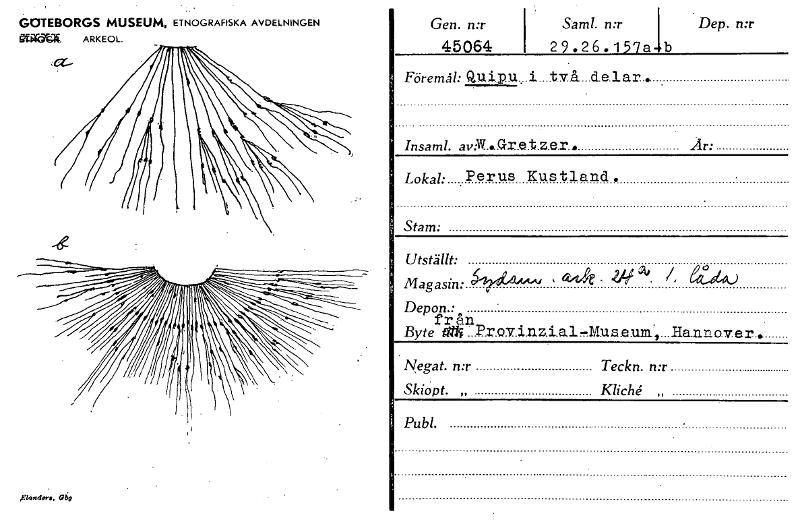
Figure 3. Accession card for a “khipu in two parts” (1929.26.0157a-b) in the
Museum of World Culture, Gothenburg (© Världskulturmuseet, made available via
Creative Commons Attribution-NonCommercial-NoDerivs 2.5 License). See the online record
at https://collections.smvk.se/carlotta-vkm/web/object/1365111.
Keys to Mathematical Treasure Chests: Andean Khipus – Collections Organized by Style and Period
The available online resources can also be grouped by the style of khipu that they document. Beginning by searching for Inka and Inka-style specimens leads us to several collections in Peru and the United States.
 Entering “quipu” in the online portal of the Museo de Sitio de Pachacamac returns some two dozen archaeological specimens that were first published as a group by the Peruvian engineer and statistician Hugo Pereyra Sánchez and colleagues [2006]. The prehispanic coastal pilgrimage site of Pachacamac is the largest known source of khipus conserved in museums today, with over 90 examples spread across collections in the Americas and Europe [Clindaniel and Urton 2017].
Entering “quipu” in the online portal of the Museo de Sitio de Pachacamac returns some two dozen archaeological specimens that were first published as a group by the Peruvian engineer and statistician Hugo Pereyra Sánchez and colleagues [2006]. The prehispanic coastal pilgrimage site of Pachacamac is the largest known source of khipus conserved in museums today, with over 90 examples spread across collections in the Americas and Europe [Clindaniel and Urton 2017].
 Similarly detailed online descriptions await users of the Museo Larco’s collection database (search “quipu”). The documentation for the 11 canonical, Inka-style results includes information on cord twist, color, and dimension, along with photographs taken from various angles.
Similarly detailed online descriptions await users of the Museo Larco’s collection database (search “quipu”). The documentation for the 11 canonical, Inka-style results includes information on cord twist, color, and dimension, along with photographs taken from various angles.
 Just as important as “textbook” Inka khipus are Inka-style examples with visible anomalies. Few museums include more such khipus than the Dallas Museum of Art (DMA). Searching the Museum’s collections returns a number of Inka-style khipus with multiple primary cords tied together, a relatively unusual phenomenon previously described at the DMA by Kylie Quave [2009].
Just as important as “textbook” Inka khipus are Inka-style examples with visible anomalies. Few museums include more such khipus than the Dallas Museum of Art (DMA). Searching the Museum’s collections returns a number of Inka-style khipus with multiple primary cords tied together, a relatively unusual phenomenon previously described at the DMA by Kylie Quave [2009].
Some 500 years before the rise of the Inka khipu, colorful knotted strings were used for administration and numerical reckoning in the pre-Inka Wari Empire. Despite a smaller global corpus of about 40 specimens [Splitstoser 2020], Wari khipus are well-documented online. Readers are encouraged to visit the accompanying website for a 2019 khipu exhibition at Dumbarton Oaks (DO) Research Library and Collections in Washington DC. A dedicated page on Wari khipus includes links to high-quality images and descriptions of several Wari specimens donated to DO in 2016. As for Wari khipus conserved in Peru, one striking circular example from the former collections of the khipu researcher Carlos Radicati di Primeglio serves as the backdrop to an overview of Wari khipus produced by Jeffrey Splitstoser in 2021. Colorful, tube-like thread wrappings, overhand knots, and thick pendant strings distinguish this largely undeciphered, pre-Inka khipu tradition.
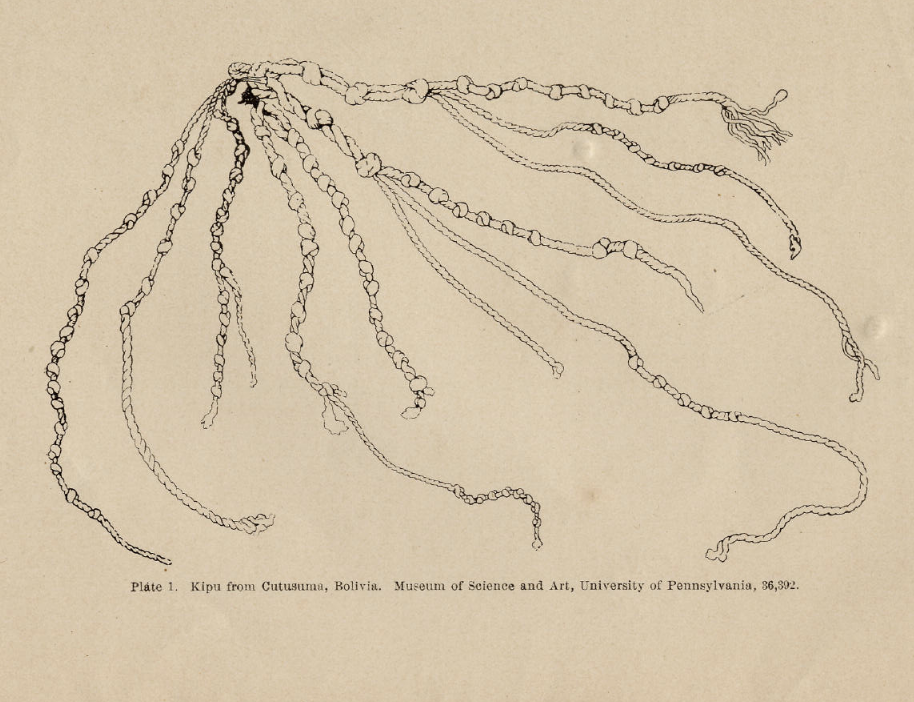
Figure 4. Drawing of a modern khipu collected by Max Uhle in 1895 [Uhle 1897, plate 1].
The remainder of the khipu’s known active lifespan comprises colonial-era and modern use (1532–ca 1950 CE). For decades following the Spanish conquest of the Inkas, complex khipus were utilized to record detailed numerical accounts, at times even being transcribed as part of Andean testimony in legal proceedings [Medrano 2021a]. Nonetheless, at present, few khipus in museums have been confidently radiocarbon-dated to this early postconquest period. Better represented online are modern khipus, utilized since the late 19th century for a wide variety of administrative, economic, and ritual purposes. Object number 36392 in Philadelphia’s Penn Museum—a khipu from Cutusuma, Bolivia—is one such example. In 1895, Max Uhle collected this specimen during an excursion to the Lake Titicaca area (Figure 4). Its strings efficiently subdivided local sheep into various categories, informing Uhle’s [1897, p. 57] claim that “modern kipus [sic] are the direct descendants of the ancient ones” (see also Loza [2000] and Hyland [2014]). Several decades later, a Jesuit priest named Antonio Sempere donated five agricultural produce khipus he had collected from Lake Titicaca’s Island of the Sun to the Smithsonian National Museum of Natural History (NMNH). The khipus, created between 1948 and 1949 and described extensively by Sabine Hyland and Christine Lee [2021], can be found online by searching “‘Colegio San Calixto’ quipu” in the NMNH collections portal.
A final note is warranted on khipu preservation and conservation science. The process by which archaeological khipus—often fragile, tangled, and faded—are prepared for long-term storage is not well-represented online, though Patricia Landa Cragg’s [2018] account of conserving recently discovered Inka khipus from a storage complex at Inkawasi is an important exception (see “Año 2, Número 6” on the journal’s website). Among khipus already in museums, Martina Brunori and Stefania Passerini [2019] have described the careful process of re-mounting a specimen in the ethnological collections of the Vatican.
Keys to Mathematical Treasure Chests: Andean Khipus – Quantitative Research and Digital Analysis
Beyond documentation and conservation, an active vein of the last 50 years has been the subjection of khipus to various mathematical, observational, and—most recently—digital analyses. Such efforts, often motivated by the goal of khipu decipherment, are widely available online. They are surveyed chronologically here.
Between the 1960s and 1980s, the identification of elaborate patterns and mathematical relationships within individual samples was a hallmark of khipu research. Carlos Radicati di Primeglio, an Italian-born scholar, dedicated decades of his life to the endeavor, identifying color schemas and numerical phenomena in his collection of specimens that revealed their purportedly “extranumerical” properties [Radicati di Primeglio 1964]. Most of Radicati’s published work was compiled for a 2006 volume, arranged by the Universidad Nacional Mayor de San Marcos, that is available online. Radicati’s successors would be an American duo, Marcia Ascher and Robert Ascher, who from the early 1970s cataloged hundreds of khipus in the Americas and Europe [Ascher and Ascher 1981]. A mathematician (Marcia) and an anthropologist (Robert), the Aschers produced two “Databooks,” today preserved on a Cornell University webpage, that list cord-by-cord observations and internal arithmetic relationships for over 200 samples. Another webpage preserves some of the Aschers’ own photographs of the specimens. An overview of the Aschers’ mathematical investigations appears in a 2021 lecture of mine to Gresham College, London.
 The Ascher Databooks provided most of the initial entries for the first digital khipu database, which was designed and implemented by Carrie Brezine at Harvard University beginning in 2002. Now managed at the University of Chicago, the Open Khipu Repository (OKR) is open source and stores detailed, downloadable information on 630 khipus from around the world. A newly-formed independent advisory board for the OKR, presently consisting of Carrie Brezine, Jon Clindaniel, Ivan Ghezzi, Sabine Hyland, and me, is working to ensure that khipu research is transparent, inclusive, and accountable going forward; we have recently published a number of concrete steps toward this end [OKR Team 2022].
The Ascher Databooks provided most of the initial entries for the first digital khipu database, which was designed and implemented by Carrie Brezine at Harvard University beginning in 2002. Now managed at the University of Chicago, the Open Khipu Repository (OKR) is open source and stores detailed, downloadable information on 630 khipus from around the world. A newly-formed independent advisory board for the OKR, presently consisting of Carrie Brezine, Jon Clindaniel, Ivan Ghezzi, Sabine Hyland, and me, is working to ensure that khipu research is transparent, inclusive, and accountable going forward; we have recently published a number of concrete steps toward this end [OKR Team 2022].
Combining these records with an additional database stored locally at the MNAAHP (the second-largest khipu collection, see above), today some 866 khipus are stored in full digital format, about 60% of the known total [Medrano 2021b, p. 117]. The history of their cataloging and digitization since 1920 is reproduced in Figure 5. Note the significant spike in the bolded line in the late 1970s, coinciding with the Aschers’ research. More fine-grained analyses are possible by subdividing geographically; the history of European khipu cataloging reproduced in Figure 6 is one such example. The OKR’s relational database uses a standardized khipu recording schema described in a recent video from the British Museum’s preparation of OKR data in 2021. Peruvian archaeologist Alejo Rojas Leiva [2009] and others have contributed to ongoing discussions surrounding best practices in the digital encoding of khipus.
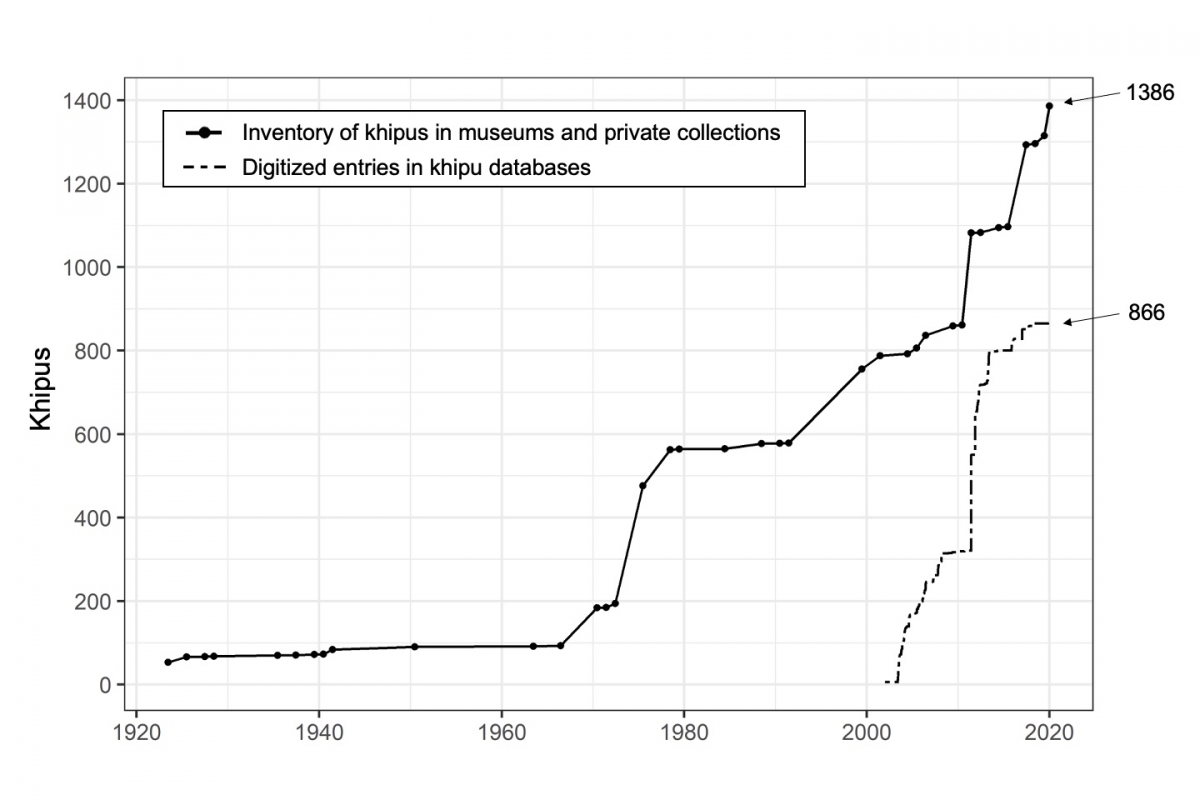
Figure 5. Worldwide khipu cataloging and digitization efforts, 1920–2020 (graph by Manuel Medrano).
Figure 6. Dynamic map of khipu cataloging in European museums, 1920–2020. Note the world’s largest
khipu collection at the Ethnologisches Museum, Berlin (animation by Manuel Medrano).
The widespread availability of khipu data has both enabled and encouraged a wide variety of new digital initiatives in the last five years. An exciting entry point for the uninitiated is The Khipu Keepers [2021], an online compilation of research overviews produced by Google Arts & Culture and the Museo de Arte de Lima (MALI), in consultation with multiple specialists. High-quality images of Wari, Inka, colonial, and modern khipus appear throughout. Additionally, Cecilia Pardo of the British Museum has presented a thoughtful khipu overview in connection with the Museum’s first major Peruvian exhibition [2021], as has Kylie Quave in a thoroughly illustrated essay for the art history platform Smarthistory [2022].
 The Khipu Keepers project emerged in part from a major khipu exhibition at the Museo de Arte de Lima in 2020–2021, which has been digitally preserved in 3D. See the annotated exhibition online on the Google Arts & Culture platform, or the original scan maintained on Matterport.
The Khipu Keepers project emerged in part from a major khipu exhibition at the Museo de Arte de Lima in 2020–2021, which has been digitally preserved in 3D. See the annotated exhibition online on the Google Arts & Culture platform, or the original scan maintained on Matterport.
Readers interested in visualizations and computational analyses of OKR data are encouraged to explore the Khipu Field Guide (KFG), a new project by independent researcher Ashok Khosla. In addition to highly-detailed symbolic renderings of over 600 OKR khipus (e.g., Figure 7), users can explore interactive graphics accompanying Khosla’s exploratory data analysis. The KFG investigations are a welcome addition to previous computational work on the OKR carried out by Carrie Brezine (published in Urton [2006]) and Jon Clindaniel [2019].
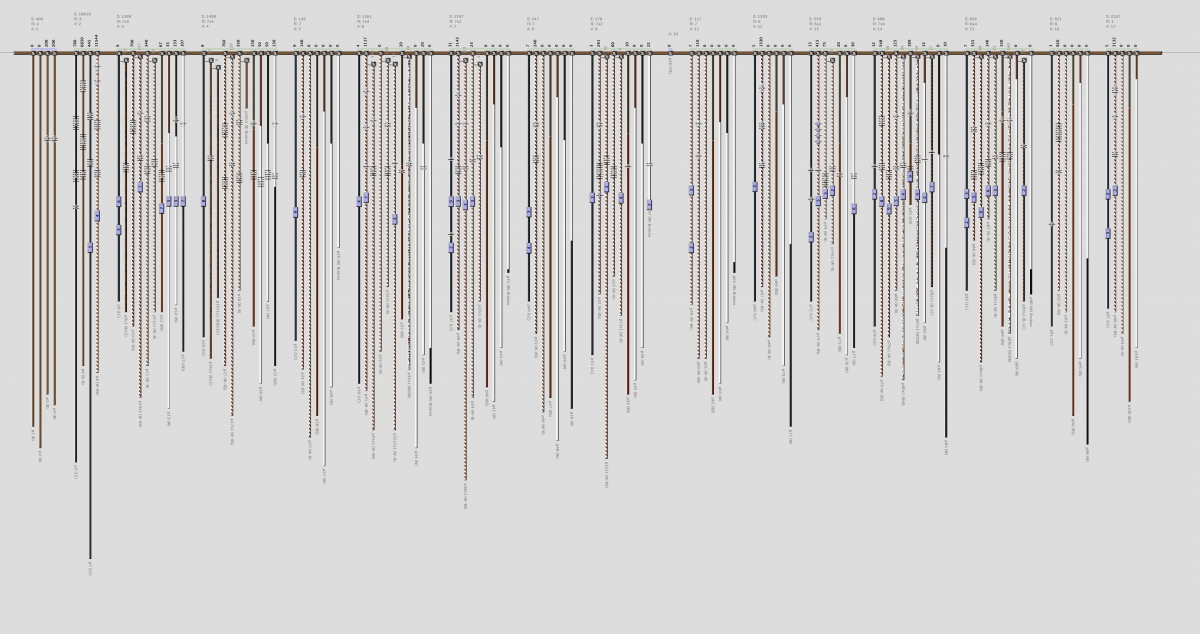
Figure 7. Symbolic diagram of khipu VA 42554, Ethnologisches Museum, Berlin, rendered from OKR data (diagram courtesy of Ashok Khosla). The khipu itself can be found online in the Museum’s collections database.
Finally, those seeking more exploratory visualizations can peruse a series of 3D models of Wari and Inka khipus in the Dumbarton Oaks collection created by archaeologist Alexandre Tokovinine (see https://skfb.ly/6RvtX, https://skfb.ly/6Rv7Q, https://skfb.ly/owxOI, and https://skfb.ly/6ZpXv). Though it remains in development, the 3D imaging of khipus holds significant promise for future analyses, capturing the multidimensionality of their strings and knots in visually striking ways.
Keys to Mathematical Treasure Chests: Andean Khipus – Conclusion and References
Conclusion
As we near the 100-year anniversary of Leland Locke’s The Ancient Quipu or Peruvian Knot Record [1923], this survey of khipu studies’ online footprint has endeavored to highlight the sheer variety of resources created since Locke’s decipherment of the numerical “khipu code.” Khipus of different times and places are maintained in the high-quality online records of dozens of museum institutions, with an ever-growing percentage encoded in an existing, open-source khipu database. Rich documentation and analyses await the online reader invested—like today’s handful of khipu researchers—in someday fully deciphering the primary sources of the ancient Andes.
References
Adawi Schreiber, Luis, Alexander Ortegal lzquierdo, Marlene Mejía Pérez, and Alejo Rojas Leiva. 2011. “Una aproximación al estudio de los quipus del MNAAHP.” In Atando cabos, edited by Carmen Arellano Hoffmann and Gary Urton, 239–63. Lima: Ministerio de Cultura del Perú and Museo Nacional de Arqueología, Antropología e Historia del Perú.
Ascher, Marcia, and Robert Ascher. 1981. Code of the Quipu: A Study in Media, Mathematics, and Culture. Ann Arbor: University of Michigan Press.
Barraza Lescano, Sergio, Rodrigo Areche Espinola, and Giancarlo Marcone Flores. 2022. “By Stones and by Knots: The Counting and Recording of Chili Peppers Stored During the Inca Occupation of the Guarco Administrative Center of Huacones-Vilcahuasi, Lower Cañete Valley, Peru.” Andean Past 13: 221–64.
Brunori, Martina, and Stefania Passerini. 2019. “Sixteenth-century Peruvian Quipu.” In Reports from the Ethnological Materials Laboratory 4, edited by Stefania Pandozy, 68–75. Vatican City: Musei Vaticani.
Clindaniel, Jon. 2019. “Toward a Grammar of the Inka Khipu: Investigating the Production of Non-numerical Signs.” PhD diss., Harvard University.
Clindaniel, Jon, and Gary Urton. 2017. “Quipus de Pachacamac. Hacia la estanderización de las convenciones de signos en el Tawantinsuyu.” In Pachacamac: El oráculo en el horizonte marino del sol poniente, 274–87. Lima: Banco de Crédito del Perú.
Gänger, Stefanie. 2014. Relics of the Past: The Collecting and Study of Pre-Columbian Antiquities in Peru and Chile, 1837-1911. Oxford: Oxford University Press.
Google Arts & Culture and MALI, Museo de Arte de Lima. 2021. The Khipu Keepers. https://artsandculture.google.com/project/khipus.
Hyland, Sabine. 2014. “Ply, Markedness, and Redundancy: New Evidence for How Andean Khipus Encoded Information.” American Anthropologist 116(3): 643–48.
Hyland, Sabine, and Christine Lee. 2021. “Indigenous Record Keeping and Hacienda Culture in the Andes: Modern Khipu Accounting on the Island of the Sun, Bolivia.” Hispanic American Historical Review 101(3): 409–32.
Landa Cragg, Patricia. 2018. “El proceso de la conservación de los quipus de Incahuasi.” Boletín Yungas 2(6): 61–62.
Locke, L. Leland. 1912. “The Ancient Quipu, a Peruvian Knot Record.” American Anthropologist 14(2): 325–32.
Locke, L. Leland. 1923. The Ancient Quipu or Peruvian Knot Record. New York: American Museum of Natural History.
Loza, Carmen Beatriz. 2000. “El modelo de Max Uhle para el estudio de los quipus a la luz de sus notas inéditas de trabajo de campo (1894–1897).” Indiana 16: 123–58.
Mackey, Carol J. 1970. “Knot Records in Ancient and Modern Peru.” PhD diss., University of California, Berkeley.
Medrano, Manuel. 2021a. “Khipu Transcription Typologies: A Corpus-Based Study of the Textos Andinos.” Ethnohistory 68(2): 311–41.
Medrano, Manuel. 2021b. Quipus: Mil años de historia anudada en los Andes y su futuro digital. Lima: Planeta.
OKR Team. 2022. The Open Khipu Repository (v.2.0.0). Zenodo. https://doi.org/10.5281/zenodo.6908343.
Pancorvo, Anel, ed. 2020. Quipus y quipucamayoc. Codificación y administración en el antiguo Perú. Lima: Apus Graph Ediciones.
Pardo, Cecilia. 2021. Inca Khipu: The record and writing system made entirely of knots. Curator’s Corner. The British Museum. YouTube.
Pereyra Sánchez, Hugo. 2006. Descripción de los quipus del Museo de Sitio de Pachacamac. Lima: Consejo Nacional de Ciencia, Tecnología e Inovación Tecnológica.
Quave, Kylie E. 2009. “Confronting Anomaly in the Khipu Structure: Cultural and Individual Variations from Two Museum Collections.” In Actas de las IV Jornadas Internacionales sobre Textiles Precolombinos, edited by Victòria Solanilla Demestre, 241–51. Barcelona: Universitat Autónoma de Barcelona.
Quave, Kylie E. 2022. The Inka khipu. Smarthistory: The Center for Public Art History.
Radicati di Primeglio, Carlos. 1964. La “seriación” como posible clave para descifrar los quipus extranumerales. Lima: Universidad Nacional Mayor de San Marcos.
Rojas Leiva, Alejo. 2009. “La construcción y el registro universal del quipu inca.” In Actas de las IV Jornadas Internacionales sobre Textiles Precolombinos, edited by Victòria Solanilla Demestre, 253–66. Barcelona: Universitat Autónoma de Barcelona.
Splitstoser, Jeffrey. 2020. “Los khipus Wari.” In Khipus, edited by Cecilia Pardo, 28–35. Lima: Museo de Arte de Lima.
Uhle, Max. 1897. “A Modern Kipu from Cutusuma, Bolivia.” Bulletin of the Free Museum of Science and Art of the University of Pennsylvania 1(2): 51–63.
Urbizagástegui Alvarado, Rubén. 2014. La escritura inca: Quipus, yupanas y tocapus. Lima: Hipocampo Editores.
Urton, Gary. 2006. “Censos registrados en cordeles con ‘amarres’. Padrones poblacionales pre-hispánicos y coloniales tempranos en los khipu Inka.” Revista Andina 42: 153–96.
Collections
American Museum of Natural History, New York, NY, USA.
Dallas Museum of Art, TX, USA.
Dumbarton Oaks Research Library & Collections, Washington, DC, USA.
Ethnologisches Museum, Berlin, Germany.
Museo de Arte de Lima, Peru.
Museo Larco, Lima, Peru.
Museo Nacional de Arqueología, Antropología e Historia del Perú, Lima.
Museo de Sitio de Pachacamac, Peru.
Penn Museum, Philadelphia, PA, USA.
Phoebe A. Hearst Museum of Anthropology, Berkeley, CA, USA.
Smithsonian National Museum of Natural History, Washington, DC, USA.
Världskulturmuseet, Gothenburg, Sweden.
Keys to Mathematical Treasure Chests: Andean Khipus – Acknowledgements and About the Author
Acknowledgements
I would like to thank the staff of Convergence for the invitation to prepare this article and for their comments on a previous draft. I also thank Clarissa Pacyna for her observations on an initial version of the piece.
About the Author
Manuel Medrano has researched khipus in various capacities since 2016, first as an undergraduate in Applied Mathematics at Harvard and then as a Marshall Scholar and MPhil student in the Department of Social Anthropology at the University of St Andrews, Scotland. He is now a PhD student in Latin American History at Harvard. His interests include the history of archaeology, book history, digital humanities, and the history of mathematics. He is the author of Quipus: Mil años de historia anudada en los Andes y su futuro digital (Planeta, 2021), a new book on the state of khipu research.
Keys to Mathematical Treasure Chests: Classroom Slide Rules
Slide rules are analog calculating devices that were invented in the 17th century, in part to aid with computing logarithms. Slide rules typically consist of a top and bottom frame with a sliding middle piece. All three parts are marked with scales. In general, a user chooses the two scales needed to solve an equation (one of which is on the slide), moves a transparent viewer called a cursor and marked with a guideline to the first value in the equation on the scale on the frame, moves the beginning point on the scale on the slide to be adjacent with that value, looks at the second value in the equation on the scale on the slide and moves the cursor to that point, and reads the solution from the adjacent point on the scale on the frame. The moving slide helped inspire the slide rule’s nickname of “slipstick”.
Slide rules remained in continuous use for over three centuries, but they were most widely adopted from about 1890 to 1970, when they were essential aids for the full range of engineering disciplines as well as for professionals in fields from applied mathematics to manufacturing and sales to finance. They then disappeared very quickly, thanks to the advent of electronic calculators, to the extent that anyone born after about 1980 might have seen them only in films about topics such as space exploration. For instance, the online International Slide Rule Museum’s gallery of “people with slide rules” includes screenshots from the 2016 hit Hidden Figures, which was based on the same-named nonfiction book by Margo Shetterly [Kidwell 2017].
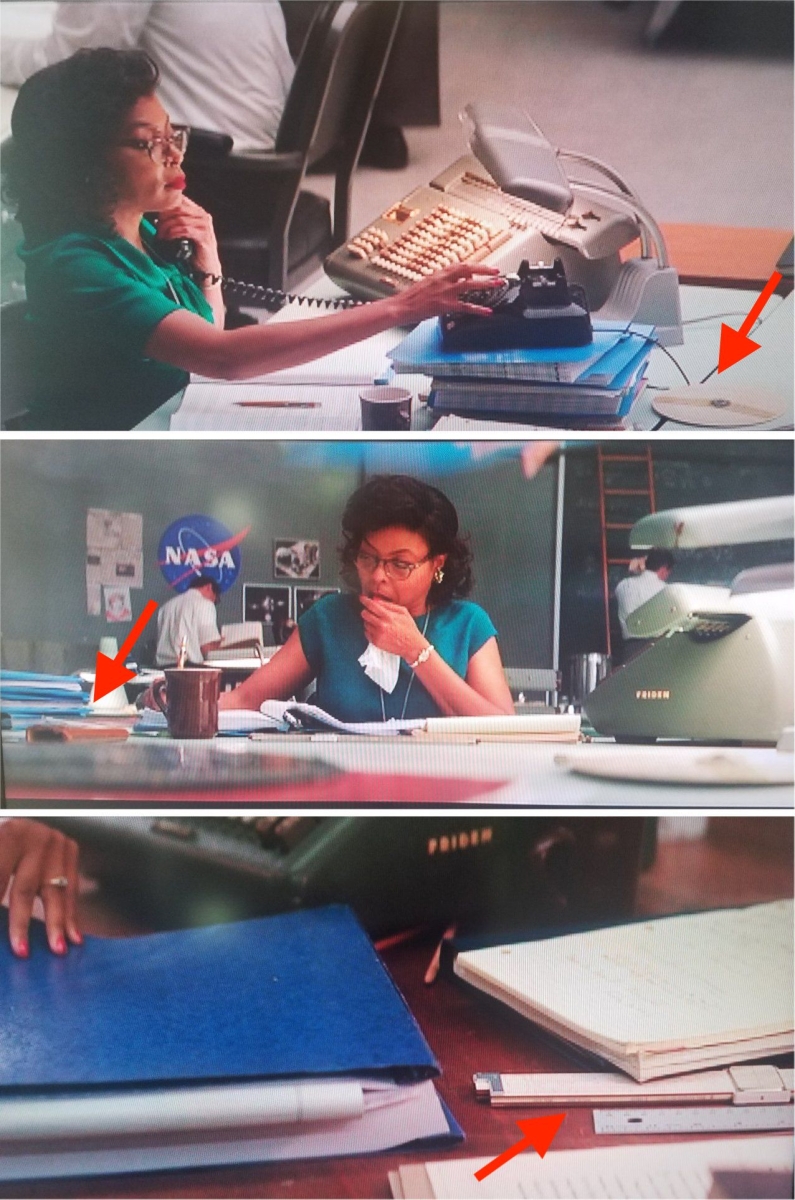
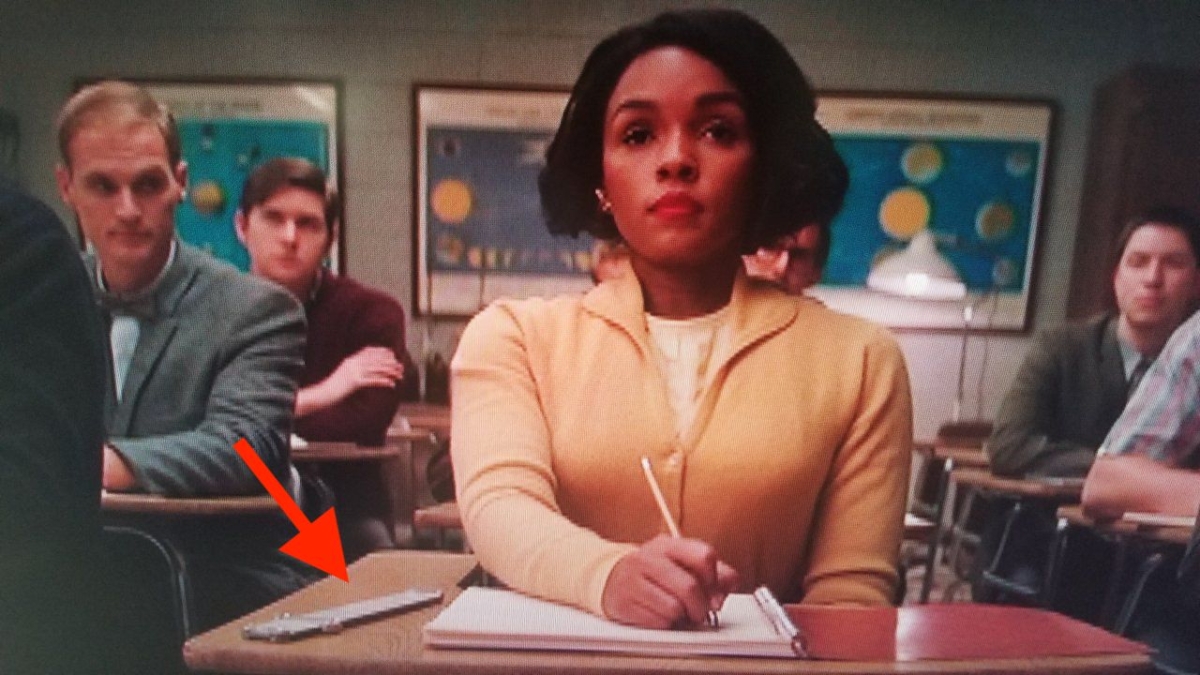
Figure 1. Slide rules on the desks of Katherine Johnson (Taraji P. Henson) and Mary
Jackson (Janelle Monáe) as shown in scenes from Hidden Figures. Note that slide rules
did not have to be rectangular in shape—some were circular, as in the top photo, or cylindrical—and
were often stored in leather cases, as in the second photo. International Slide Rule Museum.
If slide rules were once ubiquitous, it stands to reason that many people were formally taught how to use them. Indeed, scenes from A Serious Man, the 2009 film written and directed by Joel and Ethan Coen, echo real-life photographs by depicting oversized slide rules used to demonstrate calculations to a class of students.
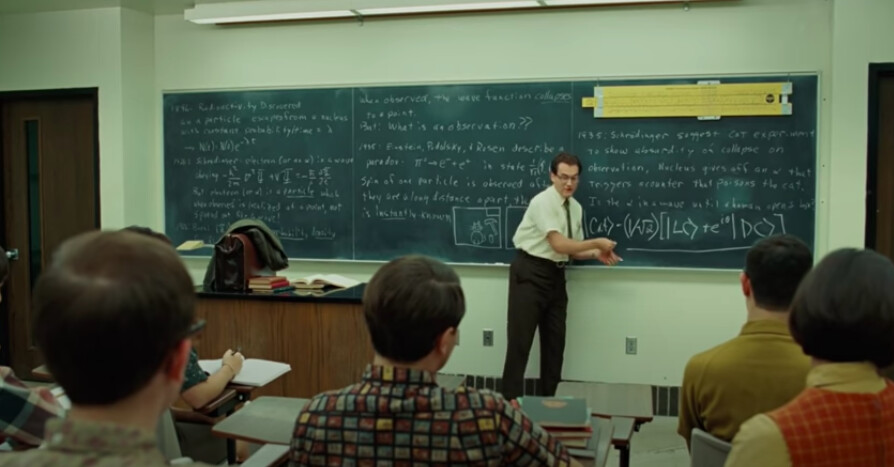
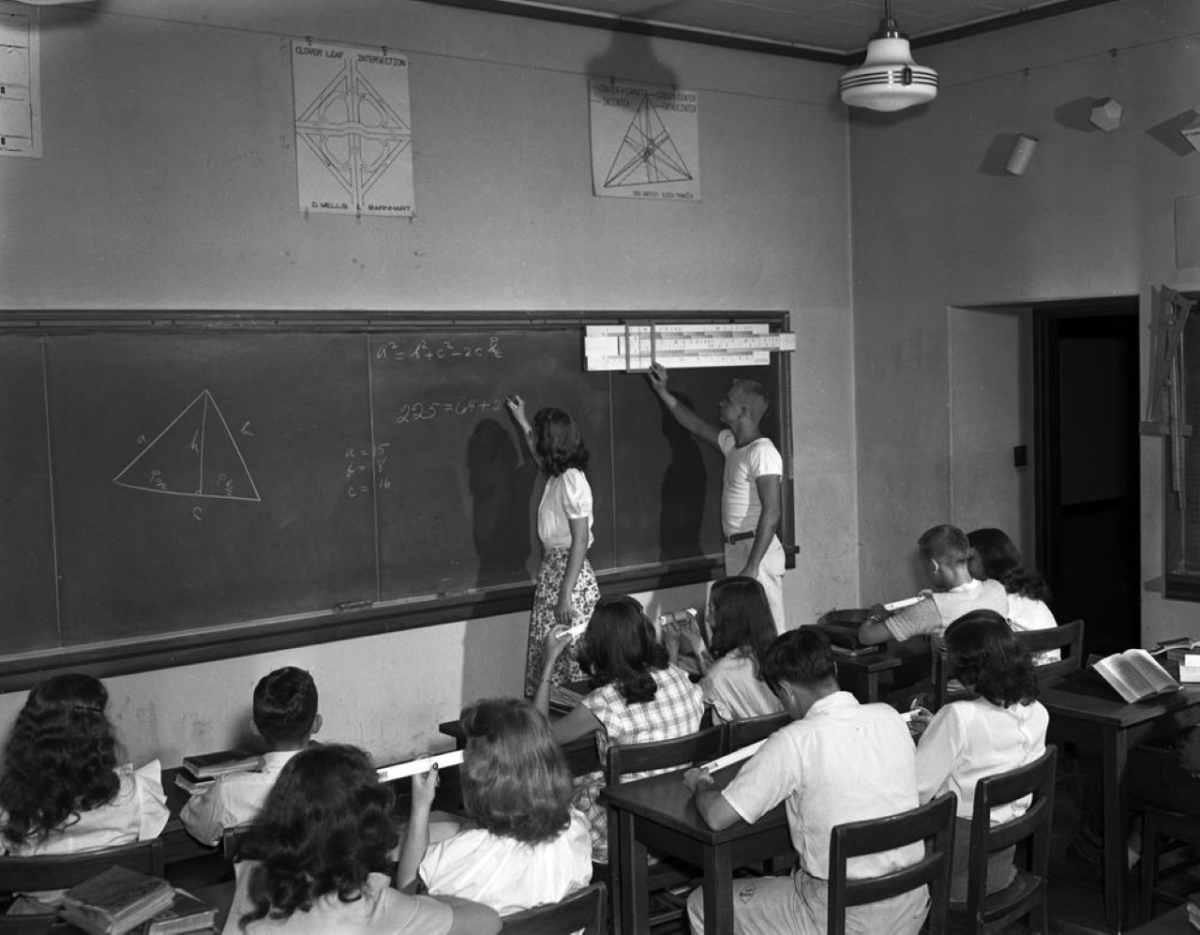
Figure 2. Above: The character Larry Gopnik (Michael Stuhlbarg) teaches a 1967 physics class with a Pickett demonstration slide rule mounted on the blackboard behind him in this screenshot from A Serious Man. Below: A demonstration slide rule (probably by Keuffel & Esser) was mounted on the blackboard in the University School mathematics class taught by Mr. Peak at Indiana University, photographed on May 8, 1947.
EdS, “Slide rules at the movies,” Retro Computing, May 18, 2021; International Slide Rule Museum.
In this installment of “Keys to Mathematical Treasure Chests,” we look at slide rules as 20th-century American high school and undergraduate students encountered them in mathematics, physics, and engineering classrooms. First, demonstration slide rules that could be mounted on walls and blackboards will be presented. Second, a few of the models designed specifically for student use will be discussed. In both cases, readers will be invited to explore online and open-access catalogues and websites containing thousands of images and descriptions of slide rules. The article will also highlight websites and emulators that offer resources for sharing this visual approach to solving equations with 21st-century students.
Keys to Mathematical Treasure Chests: Classroom Slide Rules – Rules for Demonstration
For about 200 years, slide rules in Europe were largely handmade and used mainly for specialized tasks such as carpentry and computing excise taxes on barrels of liquor. After 1850, at least three developments fostered mass production and adoption of linear (rectangular), general-purpose slide rules:
- In the instructions that accompanied his 1851 modification of a slide rule, French artillery officer Amedée Mannheim (1831–1906) suggested a selection and arrangement of scales that soon became standard, and he devised a cursor [Mannheim 1853; Cajori 1909, pp. 63–65].
- By the 1870s, German manufacturers coated wooden slide rules with celluloid (an early plastic), making them more durable and less expensive.
- Dividing engines and advanced printing techniques allowed accurate scales to be imprinted in large numbers [Ackerberg-Hastings 2012].
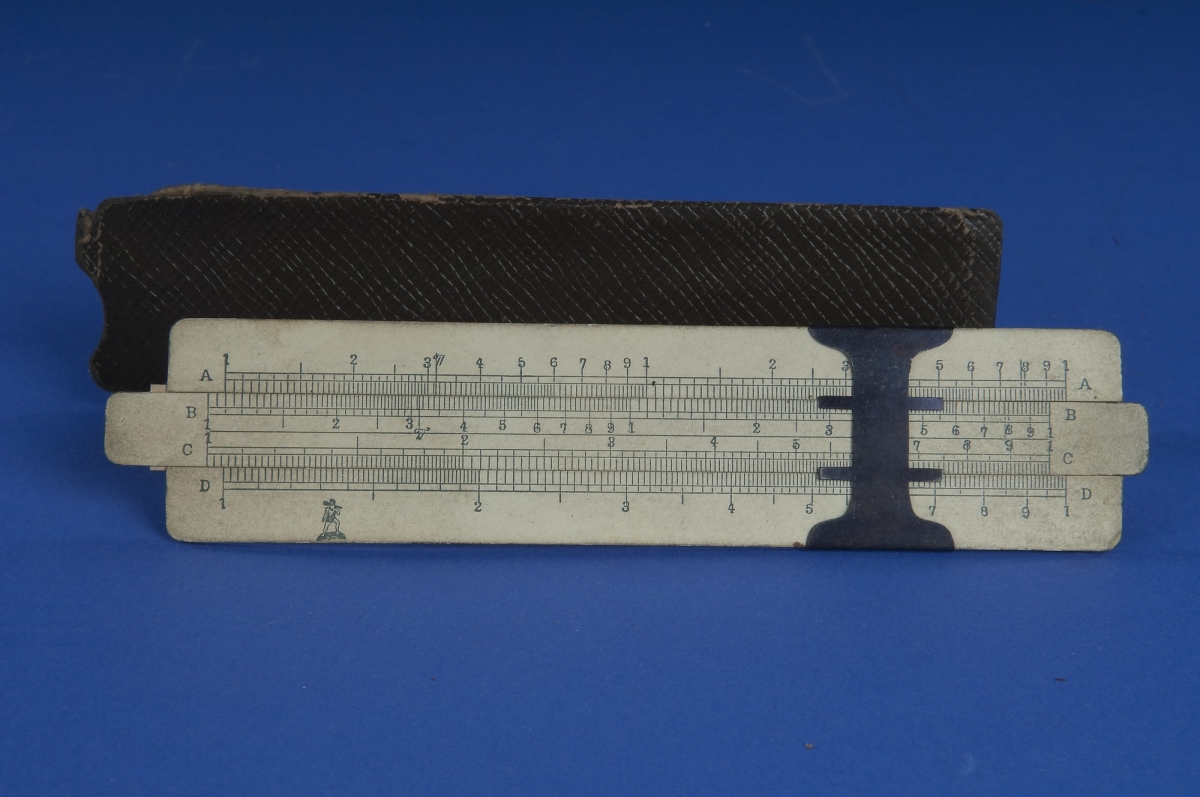
Figure 3. Gebr. Wichmann Mannheim Simplex Slide Rule, pre-1910.
The Mannheim scales permitted calculations of squares and square roots (A/B) and multiplication and division (C/D).
Smithsonian Institution negative number NMAH-DOR2010-0512.
Europeans such as Adam Burg and Josef Adalbert Sedlaczek created oversized versions of slide rules that they used to demonstrate calculations in public lectures during this time period [Rudowski 2006; Kidwell and Ackerberg-Hastings 2014]. In the United States, increased demand for slide rules coincided with the professionalization of engineering occupations and the expansion of high school and college education, which meant that instruction in how to use slide rules quickly entered mathematics, physics, and engineering classrooms [Kidwell, Ackerberg-Hastings, and Roberts 2008, pp. 105–122]. By 1906, institutions such as the State College of Washington (now Washington State University) included “one Model slide rule 80 inches long” as part of the necessary equipment for their mathematics and civil engineering departments [State College 1906, p. 38]. The faculty procured this rule from Keuffel & Esser (K&E), a New York City firm that had become a leading importer of slide rules soon after its founding in 1867 and that began manufacturing its own slide rules in 1891 [Otnes 1993]. K&E was thus presumably making demonstration slide rules available from an early date, but the earliest advertisement I have found appeared in 1924 [K&E 1924, p. 27A]. It was not until 1933 that K&E listed demonstration slide rules in its catalogs and argued that they brought efficiency to teaching:
The Demonstration Slide Rule shows all the students at one time how any operation should be carried out. It saves time and reduces the cost of instruction [McCoy n.d.; K&E 1933, p. 55, emphasis in source].
Although demonstration slide rules could be purchased individually (for $8 or $15, depending on the number of scales), K&E and later companies, such as Pickett, would also provide them for free with bulk orders of regular-sized rules.
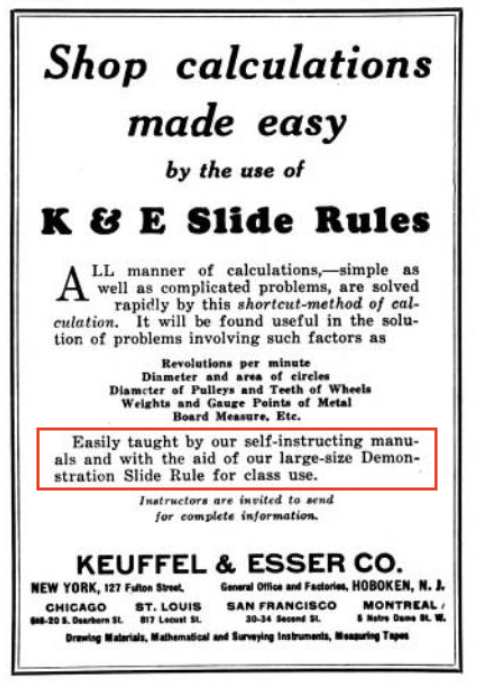
Figure 4. An early mention of demonstration slide rules (highlighted in red)
by one of the leading American manufacturers. GoogleBooks.
What did demonstration rules look like? They were typically between 3 and 7 feet long and made of painted or laminated wood. They might have scales on one or both sides; the selection of scales usually reflected those imprinted on one of a company’s popular classroom models. Metal braces could be used to hold the rule and its cursor together; the cursor was probably a plastic such as plexiglass. Eyes could be screwed into the rule for easier mounting on a wall.

Figure 5. A 4-foot demonstration version of Pickett’s N500-ES model copyrighted in 1962.
The “ES” in the model number refers to the company’s proprietary color “Eye-Saver Yellow”. Oughtred Society.
Most online collections of slide rules have all types of the instrument mixed together, so users must search by keyword and/or page through the whole collection—some of these are listed on the Collections page of this article. Additionally, demonstration slide rules tend to comprise a very small part of private and museum collections, so websites may have no more than two or three oversized rules designed for mounting on a wall or blackboard. Nonetheless, demonstration slide rules may be viewed in groups in a few collections.
 The online International Slide Rule Museum (ISRM) offers a full page of images and descriptions, most organized by manufacturer. Some captions have links to their original web locations, and some images have links to larger versions. As was implied on the previous page of this article, ISRM offers additional images of demonstration slide rules in use on its “Photos of People with Slide Rules” page. Search on the page (e.g., with “option-F” or “command-F”) for the keywords “demonstration” or “classroom”.
The online International Slide Rule Museum (ISRM) offers a full page of images and descriptions, most organized by manufacturer. Some captions have links to their original web locations, and some images have links to larger versions. As was implied on the previous page of this article, ISRM offers additional images of demonstration slide rules in use on its “Photos of People with Slide Rules” page. Search on the page (e.g., with “option-F” or “command-F”) for the keywords “demonstration” or “classroom”.
 Use the keyword “classroom” to produce a page of demonstration slide rules in the Oughtred Society’s Archive of Collections, which features items owned by members who shared images of their collections with the Society for educational purposes. Some of the rules shown are transparencies for use with an overhead projector.
Use the keyword “classroom” to produce a page of demonstration slide rules in the Oughtred Society’s Archive of Collections, which features items owned by members who shared images of their collections with the Society for educational purposes. Some of the rules shown are transparencies for use with an overhead projector.
 The single demonstration slide rule in Harvard University’s Collection of Historical Instruments is easy to call up in a keyword search.
The single demonstration slide rule in Harvard University’s Collection of Historical Instruments is easy to call up in a keyword search.
 The MIT Museum owns two demonstration slide rules, although only one had been photographed at the time this article was written.
The MIT Museum owns two demonstration slide rules, although only one had been photographed at the time this article was written.
Occasionally, physical examples of demonstration slide rules still turn up in storerooms of schools, universities, or businesses. More frequently, they can be found on auction sites such as eBay for a few hundred dollars. Rules designed for students tend to be more plentiful and less expensive for those inclined to seek them out; some suggestions for online collections are provided on the next page.
Keys to Mathematical Treasure Chests: Classroom Slide Rules – Rules for Student Use
Most slide rule manufacturers (and there were at least 800 of them [Keane 2008]) made products for a range of audiences:
- General-purpose rules for working professional, with scales capable of calculating arithmetic operations, logarithms, square and cube roots, exponents, trigonometric functions, and vectors.
- Special-purpose rules designed for specific occupations, such as radio engineers, meteorologists, or statisticians.
- Rules with a limited set of scales to train high school and undergraduate students, apprentices, and others in the process of masting computing techniques.
Hundreds, if not thousands, of models of slide rules were thus designated for student use between about 1890 and 1970. Companies like K&E vigorously advertised their student slide rules, highlighting especially the lower prices that were made possible by both fewer scales—which reduced a firm’s development time and the complexity of engraving—and, probably more significantly, cheaper materials such as cardboard and plastic. These less expensive rules were more consumable and less likely to survive for long periods of time, but so many millions of them were made that plenty can still be found in thrift stores or estate sales as well as in museum collections.
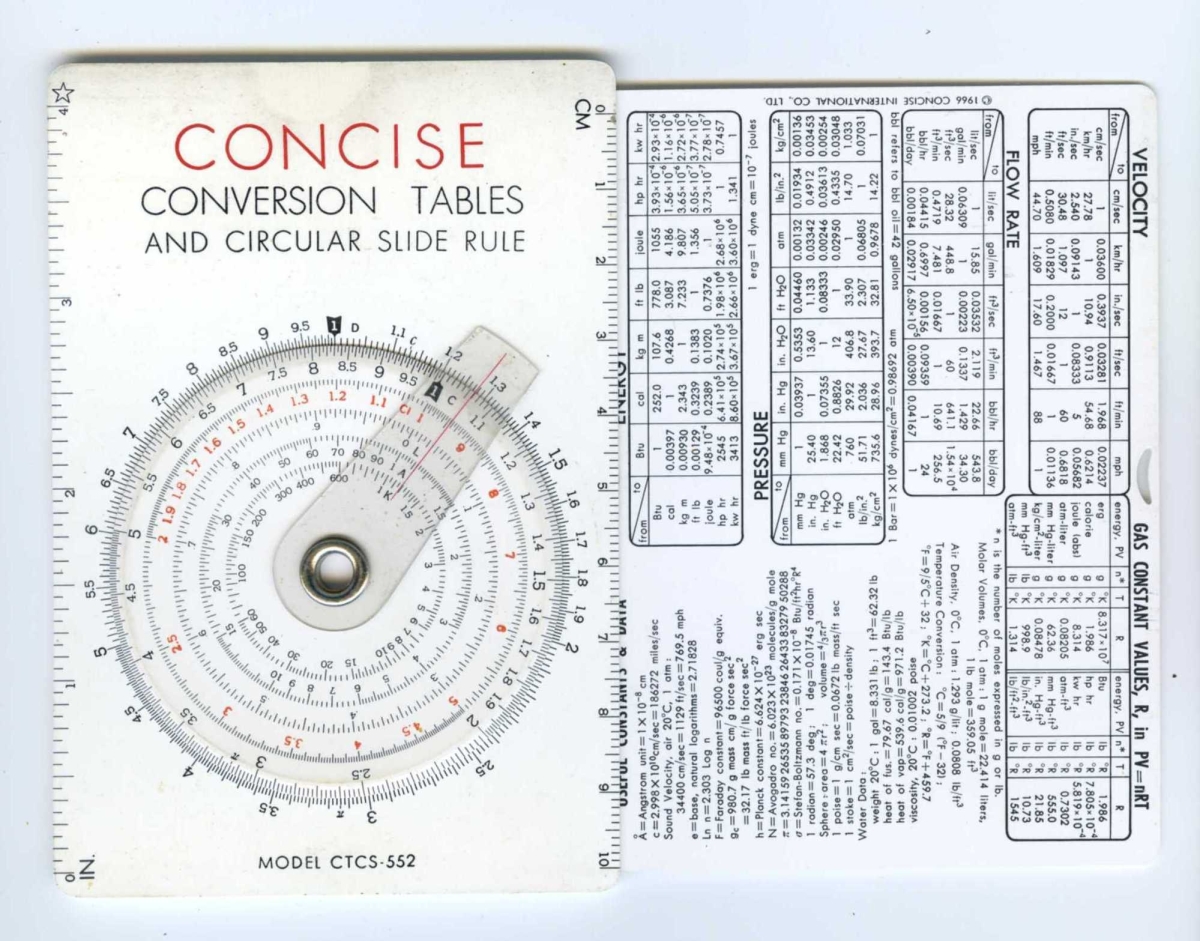
Figure 6. Although this article has focused on linear slide rules, the circular slide rule shown above was designed by students for students. It could carry out multiplication and division, determine logarithmic values, and compute squares, cubes, square roots, and cubic roots. It was distributed after 1966 by a Japanese company as model CTCS-552 under the US brand name Concise. Smithsonian Institution negative number NMAH-AHB2009q09077.
 Even though student slide rules were far more ubiquitous than demonstration slide rules, most searches on the keywords “student slide rules” again yield few results. A search on the phrase “student slide rule” using the link at the top of the home page for the International Slide Rule Museum brings up 72 objects to explore. The Oughtred Society’s Archive of Collections also comes through with a number of examples. Some other options:
Even though student slide rules were far more ubiquitous than demonstration slide rules, most searches on the keywords “student slide rules” again yield few results. A search on the phrase “student slide rule” using the link at the top of the home page for the International Slide Rule Museum brings up 72 objects to explore. The Oughtred Society’s Archive of Collections also comes through with a number of examples. Some other options:
- The Smithsonian’s Collections Search Center returns two rules and three sets of instructions, which could be used to supply manufacturers and models for additional searches.
- Harvard University’s Collection of Historical Scientific Instruments displays two objects.
- Two objects from the Computer History Center may be viewed.
- The MIT Museum has two objects so labeled, although only one has been photographed.
- The Science Museum Group provides 5 records, but only one contains an image.
 One way to do further research is to collect model numbers for one or more manufacturers or retailers and then search the internet for those model numbers. Clark McCoy’s scanned pages from K&E Catalogs and Price Lists offer an excellent starting point; K&E’s occasional Educational Products Catalogs are especially helpful.
One way to do further research is to collect model numbers for one or more manufacturers or retailers and then search the internet for those model numbers. Clark McCoy’s scanned pages from K&E Catalogs and Price Lists offer an excellent starting point; K&E’s occasional Educational Products Catalogs are especially helpful.

Figure 7. Richardson Direct Reading Slide Rule, ca 1909. George Washington Richardson (ca 1866–1940) was an individual American maker who tried to make inexpensive, basic slide rules that were affordable for students and blue-collar workers. Smithsonian Institution negative number NMAH-AHB2009q09170.
Early in the 20th century, American college professors and administrators made a concerted effort to outsource instruction in the slide rule to high schools, so that freshmen could move directly into the technical work of mathematics, engineering, and physics [Kidwell, Ackerberg-Hastings, and Roberts 2008, pp. 117–122]. Indeed, as late as the 1970s, popular cartoons were licensed to intrigue small children with the possibility of STEM careers—my parents gave me one of the Snoopy “slide rules” shown in Figure 8 when I was in elementary school. Today, both secondary schoolteachers and undergraduate professors provide enrichment activities based on slide rules. The instruments make excellent manipulatives for math circles, too. Some links to help readers get started can be found on the next page.
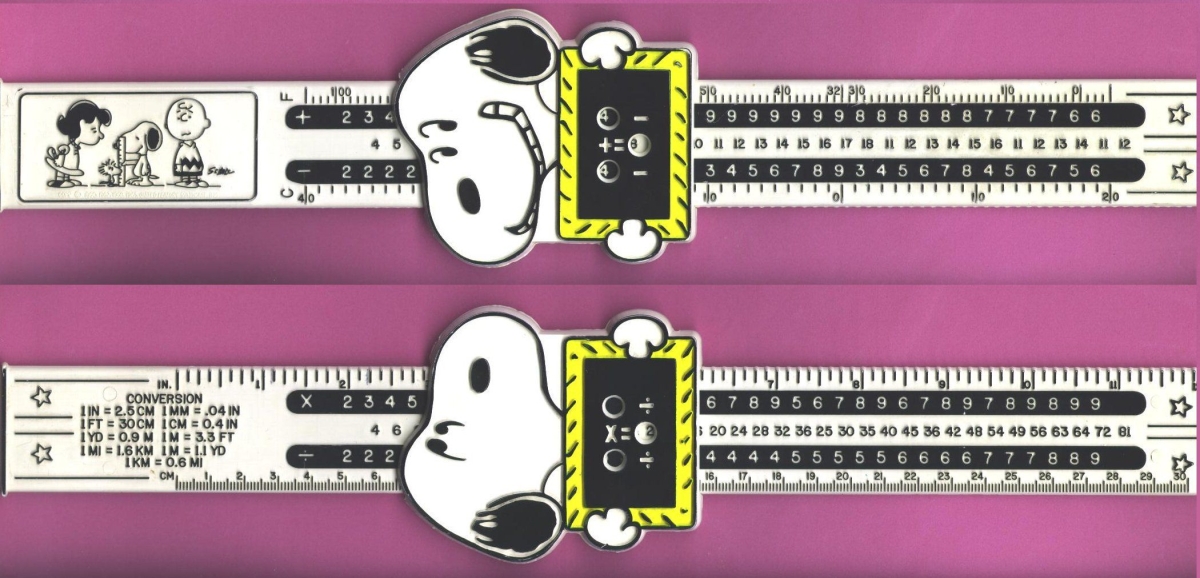
Figure 8. Snoopy Slide Rule, 1960s–1970s. International Slide Rule Museum.
Keys to Mathematical Treasure Chests: Classroom Slide Rules – Resources for Today’s Classrooms
Almost since slide rules disappeared from professional use, educators have considered ways to bring them back into mathematics classrooms. As with historical slide rules for student use, I have made no effort at a comprehensive listing of the resources available to instructors who are interested in how slide rules might “engage students in the visual experience of problem-solving, illustrate the connections between mathematics and real-life problems, and increase students’ appreciation for history” [Ackerberg-Hastings and Shell-Gellasch 2014, p. 9].
Introductory Overviews
The Reference Manual offered by the Oughtred Society may be the best single source for finding out what a slide rule is and does and learning about some of the major manufacturers [Davis and Hume 2012]. Just read carefully; by page 99 you may be tempted to become a collector yourself!
An illustrated self-guided course with 28 (brief) lessons and a link to an emulator is also available from the home page of the International Slide Rule Museum. Eric Marcotte’s chart of common scales was helpful to me when I was cataloguing the National Museum of American History’s over 200 slide rules.
How to Use a Slide Rule
If you or your students want to get started with slide rules more quickly than reading through a manual, short lessons that come up on search engines include a 1-pager by Liyen Liang of MIT and high school teacher Jay Ballauer’s Slide Rule Basics.
Do your students respond to videos? A training film from 1957 is available from the 16mm Educational Films channel on YouTube. More recently, a Professor Herning has recorded 65 videos on the general techniques of use and various specialized slide rules. Auto-generated closed captions and transcripts are available from both channels.
Online Emulators
The International Slide Rule Museum operates a free loaner program for instructors who are able to plan slide rule experiences in advance. Numerous virtual slide rules are available for immediate gratification, including 7 emulators at Derek’s Virtual Slide Rule Gallery and a collection of 43 replicas with downloadable code posted by Robert P. Wolf.
How to Make a Slide Rule
Printable templates for scales abound on the internet; several can be accessed through the International Slide Rule Museum’s Slide Rule Scales page or the General Information section of the Oughtred Society’s Links Library. In keeping with the spirit of this Mathematical Treasure Chest, Earl C. Rex explained in 1940 how to build a demonstration slide rule from lengths of baseboard [Rex 1940]. This article is available if your institution subscribes to the Wiley Online Library.
Classroom Use of Slide Rules
What might an instructor actually do with a class full of students and slide rules? In 2005 Paul R. Huff and Dagmar Rutzen both offered reports with teaching suggestions to the Journal of the Oughtred Society [Huff 2005; Rutzen 2005]. At a 2017 conference for earth educators, Victor Ricchezza of Georgia State University outlined a lab activity that uses slide rules to motivate skills for reading graphs, such as distinguishing between types of scales. He also provided files for 3D-printing slide rule bases. Richard Blake of STEMpunk offers an in-person and livestreamed presentation on “When Slide Rules Ruled,” but he has made many of the supporting materials available for free so others can use his efforts as a role model.
Keys to Mathematical Treasure Chests: Classroom Slide Rules – Conclusion, References, About the Author
Conclusion
Although organizations of slide rule collectors are justifiably worried about the aging of their membership, interest in the devices remains high and the history and use of slide rules is incredibly well-documented on the internet. This article has aimed to narrow down the resources instructors might consult by focusing on the slide rules 20th-century students would have actually encountered in high school or college classrooms: the oversized demonstration slide rule, suitable for mounting on a wall or blackboard and visible to an entire classroom at once, and the student slide rule, a label that encompasses the many models manufactured for instructional use by individuals. Today’s instructors can share images from the museum collections highlighted in this article, and they can consider implementing the activities described on the Resources page. Happy slipsticking!
References
Ackerberg-Hastings, Amy. 2012. Slide Rules as Computers and on Computers. In Proceedings of the Canadian Society for History and Philosophy of Mathematics, edited by Tom Archibald, 12–23. Vol. 25, 38th Annual Meeting. Available by request from the author.
Ackerberg-Hastings, Amy, and Amy Shell-Gellasch. 2014, December. Online Museum Collections in the Mathematics Classroom. Convergence 11.
Cajori, Florian. 1909. A History of the Logarithmic Slide Rule and Allied Instruments. New York: The Engineering News Publishing Company.
Davis, Richard, and Ted Hume. 2012. Oughtred Society Slide Rule Reference Manual (aka All About Slide Rules). Roseville, CA: The Oughtred Society.
Huff, Paul R. 2005. Slide Rules in the Classroom—An Anecdotal Report. Journal of the Oughtred Society 14(1): 12–13.
Keane, Maribeth. 2008, November 12. Calculating the Quality of Vintage Slide Rules (interview with Mike Konshak, webmaster of the International Slide Rule Museum). Collectors Weekly.
Keuffel & Esser Co. 1924, August. Shop calculations made easy. Industrial Arts Magazine 13(8): 27A.
Keuffel & Esser Co. 1933. Drawing Instruments and Materials for High Schools, Preparatory Schools and Manual Training Schools. New York.
Kidwell, Peggy Aldrich. 2017, February 9. A curator goes to the movies: The stuff of “Hidden Figures”. O Say Can You See? Stories from the Museum. National Museum of American History.
Kidwell, Peggy Aldrich, and Amy Ackerberg-Hastings. 2014. Slide Rules on Display in the United States, 1840–2010. In Scientific Instruments on Display, edited by Silke Ackermann, Richard L. Kremer, and Mara Miniati,159–172. Scientific Instruments and Collections, vol. 4. Leyden: Brill.
Kidwell, Peggy Aldrich, Amy Ackerberg-Hastings, and David Lindsay Roberts. 2008. Tools of American Mathematics Teaching 1800–2000. Baltimore: The Johns Hopkins University Press.
Mannheim, Amédée. 1853. Règle à calculs modifée. Nouvelles annales de mathématiques 12: 327–329.
McCoy, Clark. n.d. K&E Catalogs and Price Lists for Slide Rules.
Otnes, Robert K., ed. 1993. The Keuffel & Esser Issue. Journal of the Oughtred Society 2(1): 4–49.
Rex, Earl C. 1940. Construction of a Demonstration Slide Rule. School Science and Mathematics 40(2): 161–164.
Rudowski, Werner H. 2006. How Well Known Were Slide Rules in Germany, Austria and Switzerland Before the Second Half of the 19th Century? Journal of the Oughtred Society 15(2): 42–49.
Rutzen, Dagmar. 2005. Getting Hooked on Slide Rules—A Classroom Tale. Journal of the Oughtred Society 14(1): 14–15.
State College of Washington. 1906. Fifteenth Annual Catalogue of the State College of Washington. Olympia, WA: C. W. Gorham.
Collections
Collections Search Center, Smithsonian Institution, Washington, DC
History of Science Museum, University of Oxford, England
International Slide Rule Museum
K&E Company Collection and Richard (Dick) Rose Collection, MIT Museum, Cambridge, MA
Musée des Arts et Métiers, Paris, France
Science Museum Group, London, England
Searchable Galleries, Oughtred Society
Slide Rules, The Museum of HP Calculators, curated by David G. Hicks
Slide Rules, Whipple Museum of the History of Science, University of Cambridge, England
Slide Rules Object Group, National Museum of American History, Smithsonian Institution, Washington, DC
The Slide Rule Universe, Sphere Research Corporation, West Kelowna, British Columbia
University of Toronto Scientific Instruments Collection, Toronto, Ontario
Acknowledgements
I thank Peggy Aldrich Kidwell for the concept of this series and for suggestions on the draft of this article.
About the Author
Amy Ackerberg-Hastings prepared web descriptions for the slide rules in the mathematics collections of the National Museum of American History between 2011 and 2013 as part of work funded by Ed and Diane Straker. She has written numerous articles about the history of mathematical instruments and is currently co-editor of Convergence.